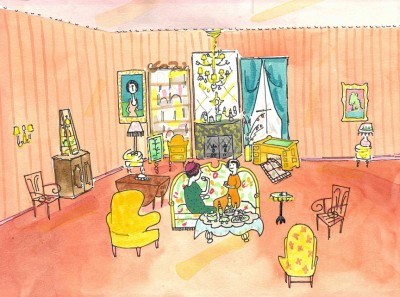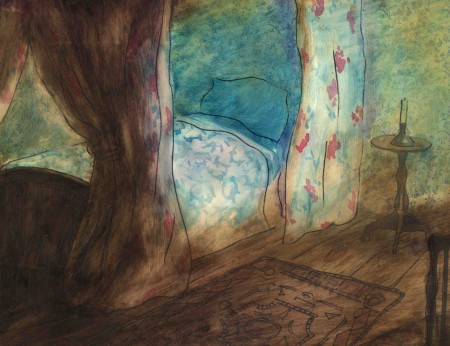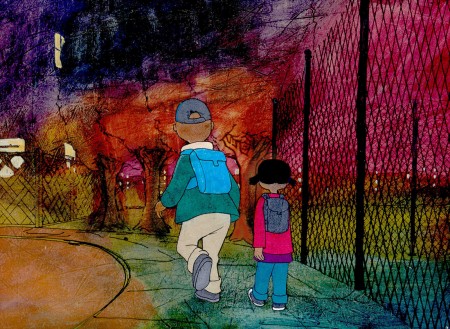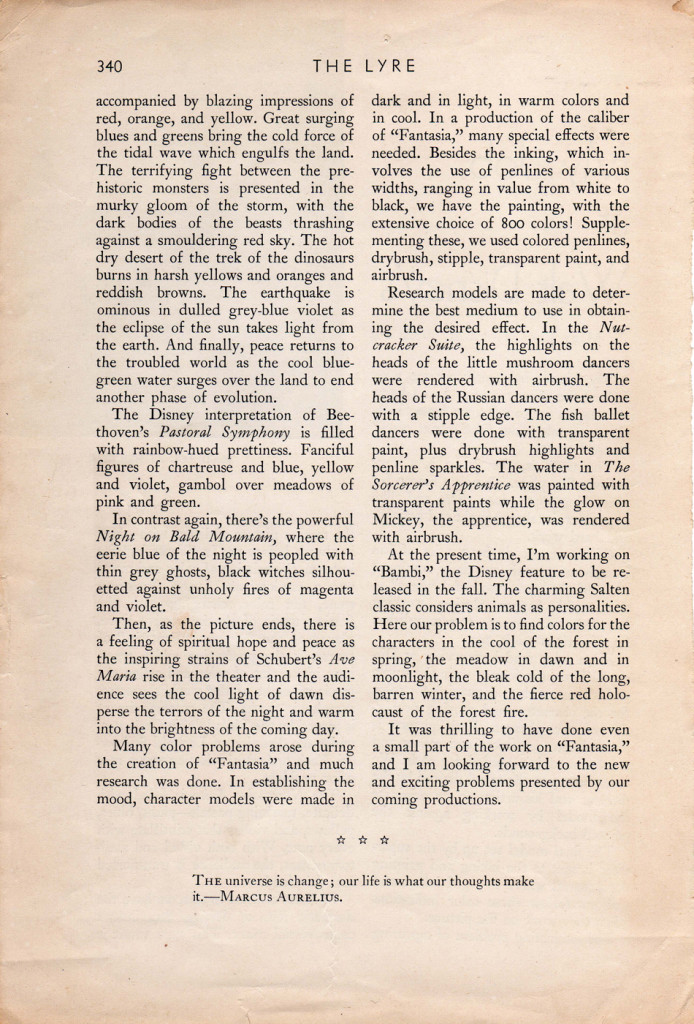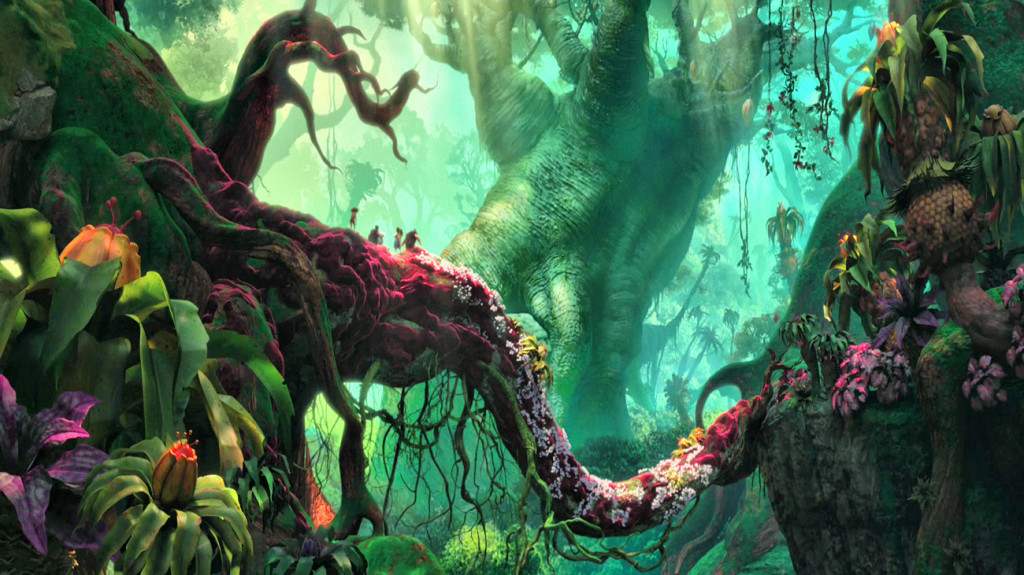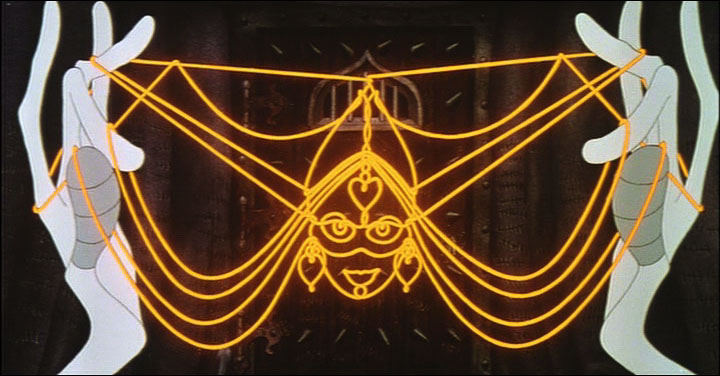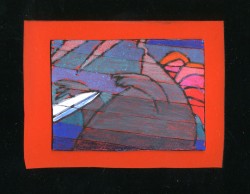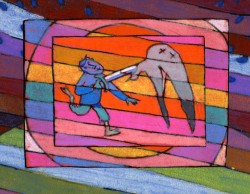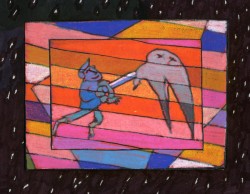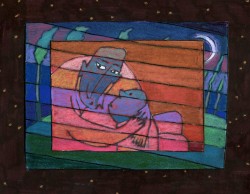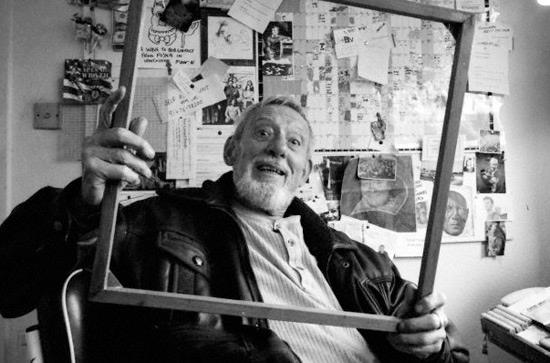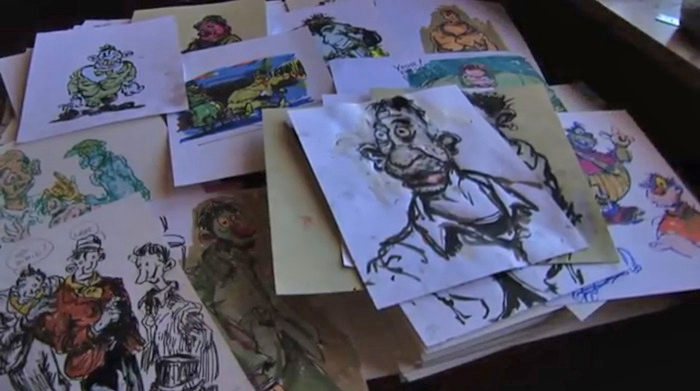Category ArchiveCommentary
Commentary &Layout & Design &SpornFilms 10 Mar 2013 03:18 am
Bridget’s Art
It’s time to put up some more Sporn Studio art. I had a couple of posts that celebrated BG art of Bridget Thorne. I’m putting a couple of these together and posting anew. Personally, I love this stuff and can’t get enough of it. I want to see Bridget doing BGs again; it’s been a while.
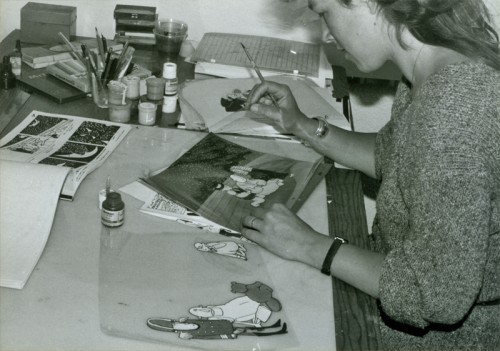
Bridget Thorne did the storyboard for
The Hunting of the Snark with me back in 1980.
We didn’t finish the film until 1989. She also painted the
backgrounds for the last third of the movie.
Bridget Thorne is someone who has been an invaluable part of the history of my films.
She has been an extraordinary Art Director and Background painter on quite a few of my favorite films produced within the studio, and I’ve put together a random sampling of some of those films.
(Click image to enlarge) Lyle, Lyle Crocodile (1987)
This painting is a key transition point in Lyle, Lyle Crocodile. The film had a looseness  that Bernard Waber‘s original book art had engendered. I felt very much at home in Waber’s style, and I think Bridget did as well.
that Bernard Waber‘s original book art had engendered. I felt very much at home in Waber’s style, and I think Bridget did as well.
She worked out a color scheme for the film, and we both agreed to follow it closely through the film. Liz Seidman lead the character coloring. Bridget, of course, had a strong hand in all those character models, as well.
The scene pictured above follows the introduction of Autumn on “East 88th Street”, and the background brings us full force into it as we get “the girl’s first song” – Mrs. Primm’s report on what it’s like to have a crocodile living in your house.
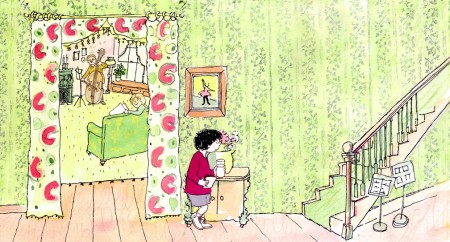 – Ira Sleeps Over was the second children’s book by Bernard Waber that we adapted. This is a very sweet story which involves a sibling rivalry; it focusses on a teddy bear and a sleep-over party. I pulled composer, William Finn, into the film and he wrote some great tunes for it. Prior to doing the script, I gave him the book and asked him to figure out where he would like the songs. In a week he had already written all the songs for the film, and they were brilliant. It turned out he used all the words of the book in his songs, and now I had to find a way of telling the same story using past, present and future tenses, as he did in the songs. It was a good challenge that worked out well and created a fabulous construction for the story.
– Ira Sleeps Over was the second children’s book by Bernard Waber that we adapted. This is a very sweet story which involves a sibling rivalry; it focusses on a teddy bear and a sleep-over party. I pulled composer, William Finn, into the film and he wrote some great tunes for it. Prior to doing the script, I gave him the book and asked him to figure out where he would like the songs. In a week he had already written all the songs for the film, and they were brilliant. It turned out he used all the words of the book in his songs, and now I had to find a way of telling the same story using past, present and future tenses, as he did in the songs. It was a good challenge that worked out well and created a fabulous construction for the story.
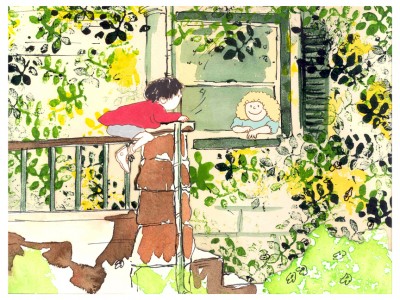 The style in this book was, if anything, looser than in Lyle. Waber did a lot of his illustration featuring duplicating printing techniques. Lino cut enabled him to repeat decorations throughout the settings. Bridget played with the lino cuts and was able to succesffully duplicate the technique in the backgrounds. In this one bg, at the beginning of the film, the foliage is a good example of this technique, printed over watercolors. The characters are markered paper drawings cut out and pasted to the cel overlays.
The style in this book was, if anything, looser than in Lyle. Waber did a lot of his illustration featuring duplicating printing techniques. Lino cut enabled him to repeat decorations throughout the settings. Bridget played with the lino cuts and was able to succesffully duplicate the technique in the backgrounds. In this one bg, at the beginning of the film, the foliage is a good example of this technique, printed over watercolors. The characters are markered paper drawings cut out and pasted to the cel overlays.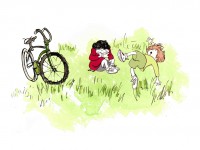
The book, like Lyle, featured a lot of white space, so we followed suit. When a book’s been in circulation for over 25 years, you have to realize there’s been a reason for it; find the reason and the heart, and take advantage of it. This use of white space made the actual backgrounds oftentimes little more than abstract shapes of color with a solid object on the screen. Here, for example, we see Ira and his friend, Reggie, playing against a blast of green and a bicycle.
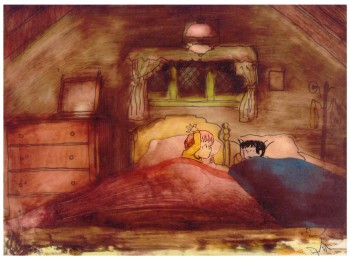 – At the end of the film, Ira and Reggie talk in the dark at the sleep-over. To get the look of the dark Bridget had to come up with something clever. The book resorted to B&W washes of gray and wasn’t very helpful. She came up with some dyes that were used for photo retouching. By quickly painting these lightly onto cel levels with a wide brush, she was able to get translucent cels with the brush strokes imbedded in the color overlays. By placing these overlays over the characters and backgrounds, we got the desired effect that let it feel connected to the very loose style of the film.
– At the end of the film, Ira and Reggie talk in the dark at the sleep-over. To get the look of the dark Bridget had to come up with something clever. The book resorted to B&W washes of gray and wasn’t very helpful. She came up with some dyes that were used for photo retouching. By quickly painting these lightly onto cel levels with a wide brush, she was able to get translucent cels with the brush strokes imbedded in the color overlays. By placing these overlays over the characters and backgrounds, we got the desired effect that let it feel connected to the very loose style of the film.
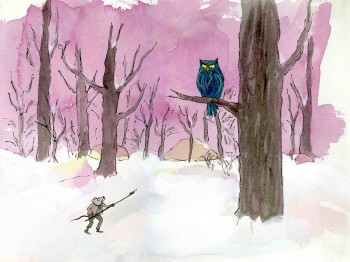 -Abel’s Island is one of the few films we did that I treasure for its artwork. Bridget’s work on the backgrounds was, to me, extraordinary. The looseness I love was developed into enormously lush backgrounds using shades of green that I didn’t know could be captured in the delicate watercolors.
-Abel’s Island is one of the few films we did that I treasure for its artwork. Bridget’s work on the backgrounds was, to me, extraordinary. The looseness I love was developed into enormously lush backgrounds using shades of green that I didn’t know could be captured in the delicate watercolors.
This film was a complicated problem that seemed to resolve itself easily and flow onto the screen without much struggle. The book had won a Newberry Award as best children’s writing of its year. It was not a picture book but a novel. The more than 120 pages featured fewer than 20 B&W spot drawings by author/illustrator, William Steig. We were on our own with the color.
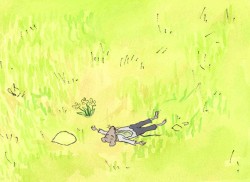 However, we had adapted Doctor DeSoto and The Amazing Bone as shorter films and could use what we’d learned from Steig on Abel. Bridget topped herself.
However, we had adapted Doctor DeSoto and The Amazing Bone as shorter films and could use what we’d learned from Steig on Abel. Bridget topped herself.
Several of the animators gave us more than I could have expected. Doug Compton‘s animation of Abel sculpting his statuary and living in his log was heart rending; Lisa Craft‘s animation of the big pocket watch, the big book and the leaf flying sequences was nothing short of inspired; and John Dilworth‘s animation of the owl fight was harrowing. This was all set up and completed by Tissa David‘s brilliant animation of Abel in the real world with wife, Amanda. She established our character.
 – At the end of the film, Abel, who has been separated from his new bride, trapped on an island for over a year, finally gets to come home. He sees Amanda in a park at twilight but decides to hold back. He races on ahead of her to greet her, privately, at home. The park sequence has a busyness as an acute counter to the lonliness we’ve watched for the previous 90% of the half-hour program. Setting it at early evening gave an opportunity for rich, royal colors. Bridget took full advantage of the opening, and underscored it all with a regal green not seen earlier. It was stunning and is one of my favorite backgrounds in the film.
– At the end of the film, Abel, who has been separated from his new bride, trapped on an island for over a year, finally gets to come home. He sees Amanda in a park at twilight but decides to hold back. He races on ahead of her to greet her, privately, at home. The park sequence has a busyness as an acute counter to the lonliness we’ve watched for the previous 90% of the half-hour program. Setting it at early evening gave an opportunity for rich, royal colors. Bridget took full advantage of the opening, and underscored it all with a regal green not seen earlier. It was stunning and is one of my favorite backgrounds in the film.
Here are two more films Bridget Thorne designed for me.
 A Child’s Garden of Verses presented new and different problems to explore.
A Child’s Garden of Verses presented new and different problems to explore.
It was a project generated by HBO. Charles Strouse and Thomas Meehan were going to write the book and song score. We met several times trying to discover a way into the book of poems. I’d suggested we use the verses in Robert Louis Stevenson‘s book to illustrate the author’s early childhood.
(Click on any image to enlarge.)
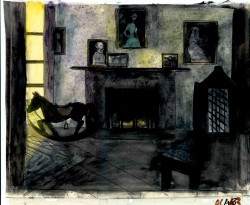 Stevenson was a sickly boy who was always confined to his dark room. He was not expected to live long. The only visitor for days on end was his overprotective mother.
Stevenson was a sickly boy who was always confined to his dark room. He was not expected to live long. The only visitor for days on end was his overprotective mother.
For much of the film, we had only the dark, child’s bedroom to explore. Artistically, I asked Bridget to delve deeper into the photgraphic dyes that she had discovered and used so well in Ira Sleeps Over. These dyes would allow us to keep the style, once again, loose while exploring dark areas and brush strokes to simulate the darkness “Robbie” lived in.
For the wallpaper throughout the house, Bridget used real wallpaper which was photostated; scaled down and reshaped to fit the backgrounds. Then watercolor washes colored these backgrounds and overlays were mixed and matched to get the desired results.
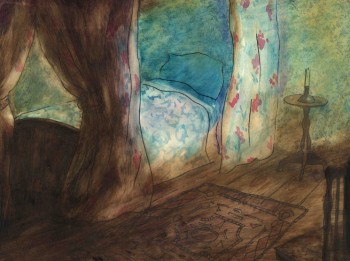 I was never quite pleased with this film. The elements that worked well worked really well. Bridget’s work was a highlight. The acting was extraordinarily good. Heidi Stallings performed with an enormous amount of emotion yet barely raised her voice above a whisper. Jonathan Pryce was brilliant as Robert Louis Stevenson, the narrator and even sang a song when asked at the last minute. Gregory Grant as the young “Robbie” was vulnerable, sweet and all we could have hoped for.
I was never quite pleased with this film. The elements that worked well worked really well. Bridget’s work was a highlight. The acting was extraordinarily good. Heidi Stallings performed with an enormous amount of emotion yet barely raised her voice above a whisper. Jonathan Pryce was brilliant as Robert Louis Stevenson, the narrator and even sang a song when asked at the last minute. Gregory Grant as the young “Robbie” was vulnerable, sweet and all we could have hoped for.
However, there was too much of a rush given the delicacy of the piece, and the exterior backrounds done by me for the end of the film are poor. The animation is also hit and miss. Oddly enough, my favorite sequence used little actual animation but intense camera work. Ray Kosarin was the animator in charge of it, and it’s an impressive sequence.
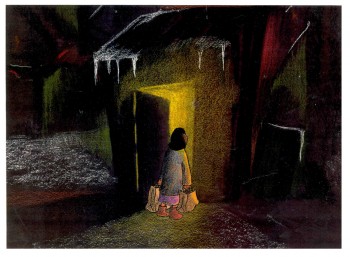
- The Talking Eggs was done for a PBS series called Long Ago & Far Away. It was an adaptation of a Creole Folk Tale which Maxine Fisher updated for me. (Lots of discussion between WGBH, Maxine & me about what distinguishes a Folk Tale from a Fairy Tale. It seriously impacted the story we were telling and I wanted what I wanted and got.)
Bridget chose to use pastels and we searched for a paper that would bring out the most grain. I loved the end result. The characters, to match the look of the Bgs, were xeroxed onto brown kraft paper and colored up from there with prismacolor pencils. This was cut out and pasted to cel.
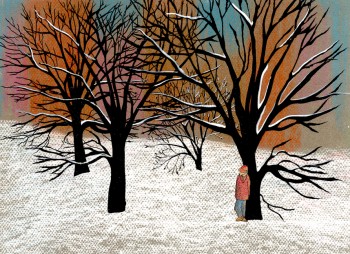 Danny Glover was the narrator, and we chose to make him an on-screen character appearing intermitently in the film. His narration was recorded on a rush as he stopped off in LA from SF on his way to direct a film in Africa.
Danny Glover was the narrator, and we chose to make him an on-screen character appearing intermitently in the film. His narration was recorded on a rush as he stopped off in LA from SF on his way to direct a film in Africa.
There’s a focus in these backgrounds that matches the content and mood of the piece, and it worked wonderfully for my purposes. I always like it when the medium is front and center; I want audiences to know that they’re watching animated drawings, and texture usually helps to do this. Of course, I also want the films to have a strong enough story that the audience gets past the point of knowing, to enter the film. It works some of the time, and I’m in heaven when it does.
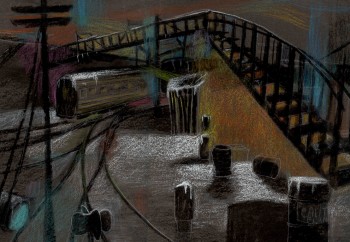 Bridget altered the color of the paper on which she was coloring with the chalks, and the different colored papers represented varied moods from sequence to sequence.
Bridget altered the color of the paper on which she was coloring with the chalks, and the different colored papers represented varied moods from sequence to sequence.
Naturally, there were some problems with the chalks under camera. All the fixative in the world didn’t stop the chalks from bleeding onto the cels or platen on the camera. (Lots more cleaning involved than usual.) We heard constantly from our cameraman, Gary Becker. The extra effort was worth it; the look was unique and successful.
The following is a short interview that we did in a publication I generated back in the ’80s.
Behind the Scenes with
Bridget Thorne
Interview by Denise Gonzalez
Bridget Thorne is a background designer who has been an important part of Michael Spom Animation for more than fifteen years. In that time she has enhanced the look of MSA films with beautiful backgrounds that are, in a way, part of the characters rather than just a scenic backdrop.
 DG: How long have you been working with Michael Sporn?
DG: How long have you been working with Michael Sporn?
BT: I first started working for Michael in 1979 on Byron Blackbear And The Scientific Method, a fifteen minute short for the Learning Corporation of America. It is actually one of my favorites. I started out as a scenic painter for plays. I worked with a designer and basically dressed the set. We’d paint the exteriors, lay in wallpaper, marbleizing floors, etc. I started at Williamstown and at Playwright’s Variety in New York, I did a lot of off Broadway and off-off Broadway.
DG: Do you see background painting as a complete picture or as a supplement to animated artwork?
BT: It’s a supplement.
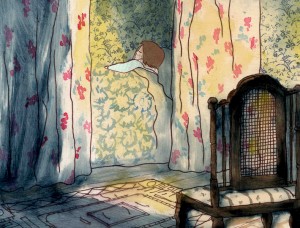 DG: How do you take that into consideration when you start the backgrounds?
DG: How do you take that into consideration when you start the backgrounds?
BT: Ideally, I take into consideration how the characters are designed. I like the characters to be part of the picture, not stand out like they do in Saturday morning cartoons. It all fits into a stylistic sensibility or pace more than anything else. I’m not a cartoon snob, I’m more of a two dimensional artist than a filmmaker. I design my backgrounds and line style according to the way the characters are designed. What I used to try and do was color the backgrounds, to match the colors of the characters. You work out of your home rather than at the studio. What are the benefits or drawbacks of working this way? I’ve just started doing this and yes, there are benefits. I can get into my own head, and I take off more with ideas because I’m not interrupted as much. But I like being in the studio and staying with the rest of the production as it goes along.
DG: Do you prefer working on original stories or from an existing book?
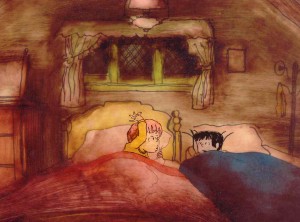 BT: It depends on the story. Let’s say IRA SLEEPS OVER, it was great working out here on that because with an existing story you have a style to imitate, and it is easy for a whole bunch of people to follow that when they’re all working in different places. So as far as production goes, that makes it easier. The great thing about original scripts is that they allow for an incredible amount of individual input. What do you take into consideration when designing the look of a film and what preparation is involved? It depends on the story. I tend to have a knee jerk reaction at first or an impulse. I have a Fine Arts background, and I tend to rely on painters. I find fine artists are more in tune stylistically with Michael’s films than the more hard-edged graphic cartoons. (Though I will look at Disney inspirational drawings.)
BT: It depends on the story. Let’s say IRA SLEEPS OVER, it was great working out here on that because with an existing story you have a style to imitate, and it is easy for a whole bunch of people to follow that when they’re all working in different places. So as far as production goes, that makes it easier. The great thing about original scripts is that they allow for an incredible amount of individual input. What do you take into consideration when designing the look of a film and what preparation is involved? It depends on the story. I tend to have a knee jerk reaction at first or an impulse. I have a Fine Arts background, and I tend to rely on painters. I find fine artists are more in tune stylistically with Michael’s films than the more hard-edged graphic cartoons. (Though I will look at Disney inspirational drawings.)
Then I look at the layouts and the character design, so I sort of work on intuition and impulse. Then I look at the existing elements and put those all together and come up with a design. As far as preparation goes, what I consistently do is make 5×4 sketches of design ideas. For ABEL’S ISLAND I did lots and lots of little paintings of winter and fall and spring.
First three illustrations pictured above:
1. BYRON BLACKBEAR AND THE SCIENTIFIC METHOD.
2. A CHILD’S GARDEN OF VERSES.
3. IRA SLEEPS OVER
DG: When designing the film do you take into consideration that this will be seen by a child?
BT: I’m not a cartoony person so I don’t think about that. I tend to think more — sometimes I run into trouble this way — I think of it in a frame and ideally what I really want is a balanced look on the screen. A lot of times that’s hard because what I see in front of me is so different when it is filmed.
DG: What do you consider to be the best example of your work thus far?
BT: I guess ABEL’S ISLAND. I was able to abstract a little. I wasn’t confined to chairs and bureaus. I was able to match the mood of the movie to the backgrounds. If Abel was in trouble, I could put colors that indicated that, or I could abstract it. If something was calm I could paint it calmly. Abstraction, or looseness, is more my personal style. This is true of Michael’s style, as well.
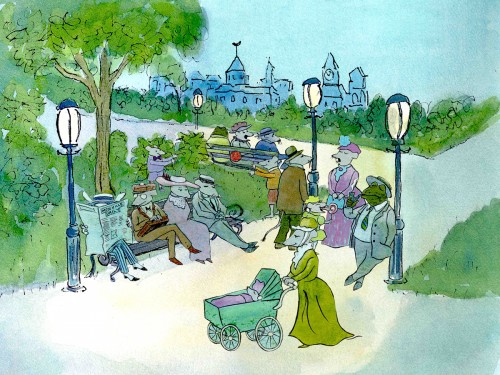
A scene toward the end of ABEL’S ISLAND.
DG: Have you ever worked on a film you couldn’t connect with?
BT: I’d say yes. It’s a hard question to answer off the top of my head. I sort of think of movies like they were kids; they are either noisy or funny or quiet or sad. They all have their own characteristics, and it is really the process of making the movie that attracts me to animation. I tend to have different feelings about each movie. But yes, sometimes a story irritates me or something comes in and it doesn’t suit my style or what I imagined. It can be very difficult. That’s an interesting thing about animation; there is really a sense of compromise; you are compromising all the time.
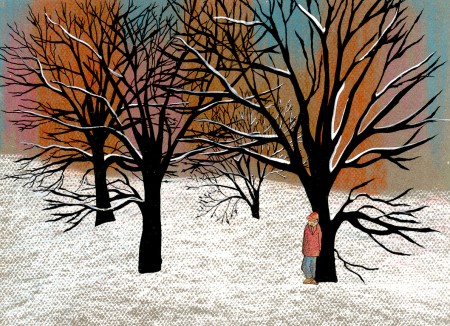
A scene of the narrator at the end of THE TALKING EGGS.
Commentary 09 Mar 2013 06:44 am
Comment Saturday
I haven’t mentioned yet that this is the 33rd year my studio’s been in business officially. That means Michael Sporn Animation, Inc. is as old as Christ was when he was shot down. I think it may make us the oldest studio in the City, by a mouse hair.
Buzzco is right up there, but I believe they didn’t officially incorporate until 1985. I have Feb 6, 1980 as my official start date in NYC.
Mary Louise Whitham Eastman
_____________________________
Tony Eastman wrote me to say that his mother, Mary Louise Whitham Eastman, passed away last Wednesday, February 27th, 2013. She would have been 98 on April 30th.
He attached an article that he thought we would find interesting. It was published
in her sorority magazine sometime between her graduation from UCLA in 1937 and
marriage to her husband, P.D. Eastman, on April 26, 1941.
Tony’s parents met at Disney’s studio in the 30′s.
All our sympathies go out to Tony and his family as we also mourn the loss of this important woman.
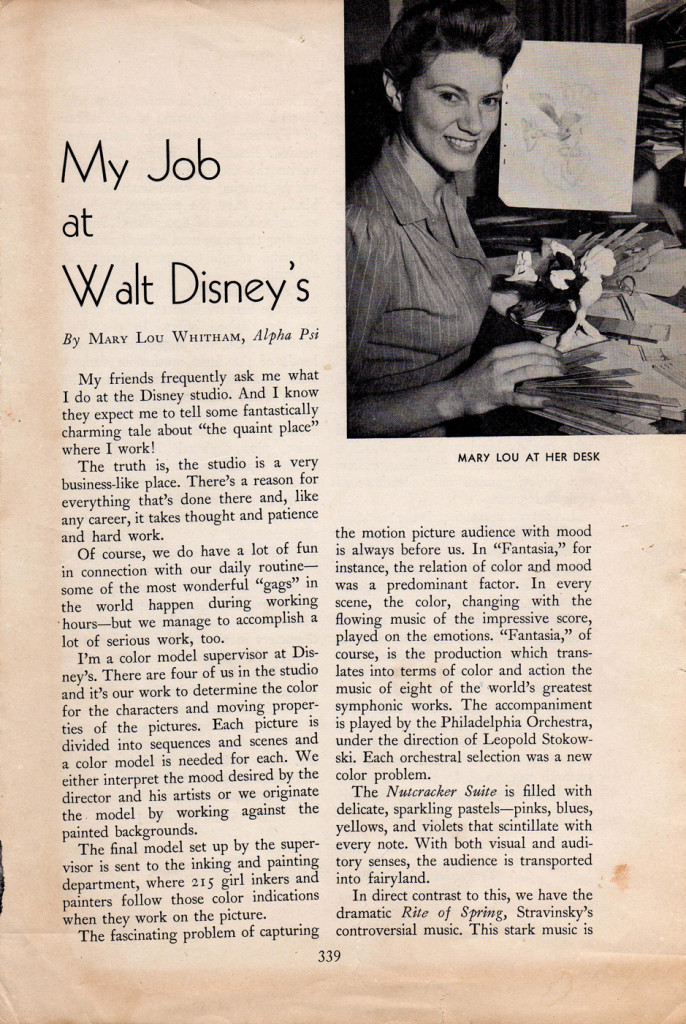 1
1(Click any image to enlarge.)
Philip Dey Eastman, Tony’s father, of course, wrote the script for Brotherhood of Man, Private Snafu and Gerald McBoing Boing as well as many other UPA classics. he went on to write and illustrate his own popular titles for the Dr. Seuss Beginner Books series
A Wiz isn’t just a Wiz
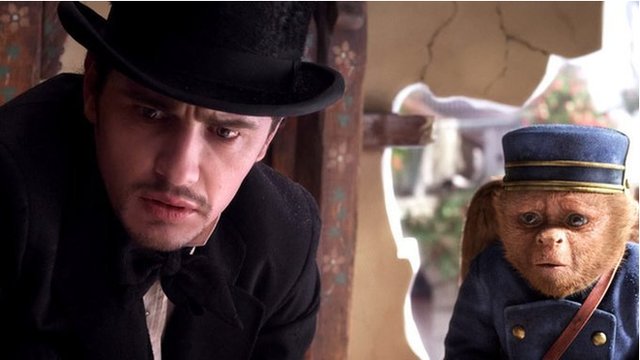
One of the two fine actors in the new movie, and it isn’t John Franco.
Maybe this should be about how all those great character actors were great radio personalities, and there ain’t a one of ‘em today. Frank Morgan, Margaret Hamilton, Billie Burke, Ray Bolger, and Charley Grapewin were all big radio stars.
Frank Morgan was a good ol’ character actor. His one real role claim to fame was as the Wizard of Oz in the movie of the same name. He was the guy behind the curtain who had that traveling magic wagon in the B&W sections of the film. His voice carried the character every bit as much as his acting. In the new movie, John Franco is supposed to be the young Frank Morgan. Not a chance in hell could one guy be the other. Franco is limited as an actor and keeps giving the same thing over and over again in the new movie.
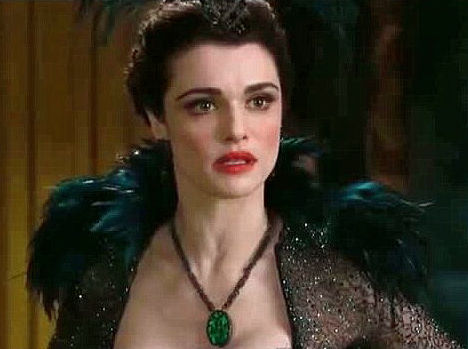 As a matter of fact, I think there were only two great performances in that film. I liked Mila Kunis until Rachel Weisz showed up and we got to see what real acting was – it made me knock my estimation of Ms. Kunis down about five chips. Without chewing the scenery, Ms. Weisz played evil of the nastiest kind. Another great performance by Mrs. Daniel Craig.
As a matter of fact, I think there were only two great performances in that film. I liked Mila Kunis until Rachel Weisz showed up and we got to see what real acting was – it made me knock my estimation of Ms. Kunis down about five chips. Without chewing the scenery, Ms. Weisz played evil of the nastiest kind. Another great performance by Mrs. Daniel Craig.
Michelle Williams is also an excellent actress but she’s at least four octaves away from Billie Burke, who played the original Glynda, the good. It took a little while but I warmed up to Ms. Williams; I never warmed up to John Franco as the wizard. As a matter of fact, I also have to wonder about the idea of building this film around a guy. Dorothy was vulnerable and it took the entire movie for us to realize she had the strength to carry all of those weak characters through Oz defeating the witch and buiding up a Wizard. In the new movie we have a con man who escapes from his lies by landing in Oz. He’s just a little too loveable for me.
I also have to think about some of the jokes that were just a little out of character when, in fact, they were popping the characters in the film. For example, Rachel Weisz shouts to Michelle Williams: “Run out of bubbles, Glynda?” You had to be there; it was funny but somehow it was out of place. Maybe they needed more jokes like that for the one to have fit.
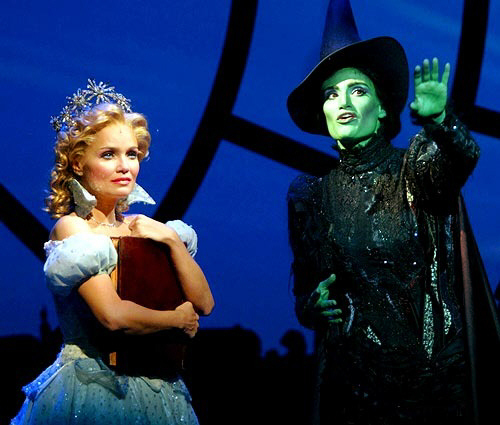 What the film really needed was songs. It was a musical without the songs. A musical uses song when the emotion is too great to be done without singing. That sure fit this film. Disney has the great tune-smith, Alan Menken, ready, willing and able to give some great tunes. I wonder if they could have gotten Steven Schwartz to do the lyrics. Remember he already wrote the musical, Wicked, which was basically the same story as this movie. Three witches fight for a guy. I can understand it if the guy is Clark Gable, but John Franco? Maybe Paul Rudd would have been the better wizard. _______Stephen Schwartz’ musical, Wicked.
What the film really needed was songs. It was a musical without the songs. A musical uses song when the emotion is too great to be done without singing. That sure fit this film. Disney has the great tune-smith, Alan Menken, ready, willing and able to give some great tunes. I wonder if they could have gotten Steven Schwartz to do the lyrics. Remember he already wrote the musical, Wicked, which was basically the same story as this movie. Three witches fight for a guy. I can understand it if the guy is Clark Gable, but John Franco? Maybe Paul Rudd would have been the better wizard. _______Stephen Schwartz’ musical, Wicked.
As a matter of fact I know he would’ve been.
Basically, this film is a bunch of cgi animated flowers and smoke and other stuff with characters like Franco escaping flying baboons et al. Somehow it just didn’t have enough imagination for me to get lost.
Oh yeah, Rachel Weisz was the one great actress. The great actor was the animated monkey that acts as slave to John Franco after they’ve met. The character didn’t overact and gave up some real sympathetic moments. Kudos to whoever animated it.
Frank Morgan did a lot of animated voices for Harman-Ising.
It’s his voice that comes in as a traveling
eyeglass salesman, at about “200″. It works nicely.
Changing Sidebar?
I’ve been thinking about doing a lot of changes to my sidebar – over there on the right of the Splog. A lot of those blogs I’d included have dwindled down to posting not much anymore, and there’s not a lot of hope that Jaime Weinman’s Something Old, Nothing New, for example, will return to his blog. Yet I keep going back. So maybe I should dump it and put down some other blog that got a lot to offer. Don’t get me wrong, I love the Weinman blog, but he doesn’t.
There are some that don’t change a lot but have a lot of good material there, and I keep going back and wandering around even though not much has changed to the site. Patti Stren, for example, has a great blog that was put together (to Patti’s specs) by the brilliante Santiago Cohen.
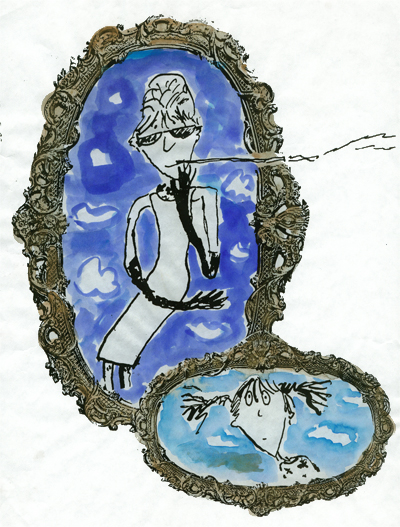 I know Patti from a great and original piece she did and she brought to me with the intent of animating it. I had that pleasure and we made a film of Mona Mon Amour. It was the diary of a young woman who gave us the rules of dating in New York City. It was great fun working on that movie short. At all the MoMA screenings we had years ago, that film got the biggest laughs. Patti also had one other book adapted to animation. Hug Me was produced by Nick Bosustow and directed by Sam Weiss. A sweet film. Patti recently did a new reworking of the book, Hug Me, and we’ve spoken about animating it. Blythe Danner has agreed to narrate it. I hope the movie happens. I could use a few laughs in my life.
I know Patti from a great and original piece she did and she brought to me with the intent of animating it. I had that pleasure and we made a film of Mona Mon Amour. It was the diary of a young woman who gave us the rules of dating in New York City. It was great fun working on that movie short. At all the MoMA screenings we had years ago, that film got the biggest laughs. Patti also had one other book adapted to animation. Hug Me was produced by Nick Bosustow and directed by Sam Weiss. A sweet film. Patti recently did a new reworking of the book, Hug Me, and we’ve spoken about animating it. Blythe Danner has agreed to narrate it. I hope the movie happens. I could use a few laughs in my life.
Anyway, if you have any thoughts about the “sidebar,” don’t be afraid to let me know in the comments section.
Explicit Signe
The British site, Skwigly currently features an extended podcast/interview with one of my favorite local animators, Signe Baumane, and I encourage your listening to it.
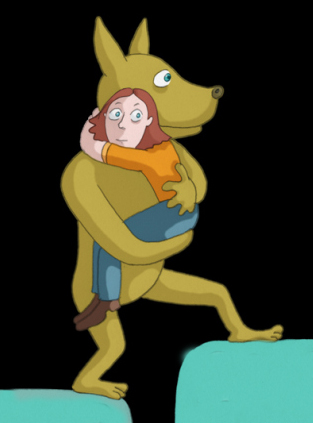 As we know, Signe has just achieved her goal of raising $43000 on a Kickstarter campaign to raise the funds to complete her feature length film, Rocks In My Pockets.
As we know, Signe has just achieved her goal of raising $43000 on a Kickstarter campaign to raise the funds to complete her feature length film, Rocks In My Pockets.
I’ve mentioned that I’d seen a rough test pre-screening of the film, and I was thrilled to report that I loved it. Lately, my body has been intolerant of bad movies. I seem to fall asleep in most of the films I go to see. In the old days, I would walk out. Now, I fall asleep. (I recently stayed awake for a full hour of the latest Mia Wasikowska film, Stoker before I walked out.)
Seeing Signe’s film on a tiny television posited atop a refrigerator some 25 feet away still kept me not only interested but wholly absorbed. I look forward to seeing the movie on a bigger screen, completed. It’s about something and it does the job of telling it well. That’s rare for film these days. This one is animated to boot!
Sqwigly warns that the conversation on the podcast is “explicit”; maybe that will encourage you. Personally, I only like explicit conversations.
See her blog while you wait for the film to show up at the local Loew’s.
Tracking Kim
It was a treat to see Kim Novak on an hour interview on TCM. She spent a bit of time talking about being bi-polar, something inherited from her father. This, of course, was an enormous problem during the Fifties. I can only imagine the difficulties she went through, just trying to care for her father. And then she said he walked out of the the premiere of Vertigo when she was hoping to finally impress him. With tears she said that he never once told her that he loved her in all his days. It was a very sad personal story.
She had built all her hopes into working with director Mike Figgis on the film, Liebestraum. However, she found that he wasn’t a good partner, and she had so little in common with the film he sought to make. She could only quit the business, which she did, retiring in the Pacific Northwest. She told this story through tears.
It was a treat watchng Bell Book and Candle again for the umpteenth time. I just love that movie. I believe Richard Quine, the director, gave advice to Jack Kinney when he directed Magoo’s 1001 Arabian Nights. They certainly shared the brilliant composer George Duning. (A great animation score.) However, only James Wong Howe could have photographed Novak and Stewart so beautifully in Bell Book and Candle.
Man of a Thousand Voices
Here’s a documentary you may have missed. It’s a one hour show about Mel Blanc and all of his Voice Over and other acting jobs. There are a lot of great interviews with people like June Foray (naturally enough), Bill Hanna, Chuck Jones and a lot of other pros.
The Rifleman
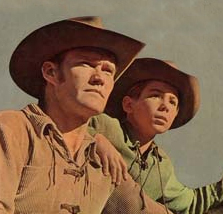 This morning at 6am, AMC ran an excellent episode of The Rifleman, that great tv show from the early 60′s starring Chuck Connors as the Rifleman, Lucas McCain, and ex-Mousketeer, Johnny Crawford, as his son, Mark. In this episode, Mark got typhoid fever drinking water from some roaming band of gypsys. The father & son were on the way to a friend’s house. The friend was played by the great character actor, Karl Swenson. A good part for Swenson, who usually only played bad guys in Westerns. Here he even got to use some kind of odd Eastern accent. You’ll know Swenson as the guy who played the voice of Merlin in Disney’s Sword in the Stone. The back story had to do with Mark’s remorse in growing up without a mother, who’d died when he was 6. A fun episode.
This morning at 6am, AMC ran an excellent episode of The Rifleman, that great tv show from the early 60′s starring Chuck Connors as the Rifleman, Lucas McCain, and ex-Mousketeer, Johnny Crawford, as his son, Mark. In this episode, Mark got typhoid fever drinking water from some roaming band of gypsys. The father & son were on the way to a friend’s house. The friend was played by the great character actor, Karl Swenson. A good part for Swenson, who usually only played bad guys in Westerns. Here he even got to use some kind of odd Eastern accent. You’ll know Swenson as the guy who played the voice of Merlin in Disney’s Sword in the Stone. The back story had to do with Mark’s remorse in growing up without a mother, who’d died when he was 6. A fun episode.
The best line of dialogue came when the doctor asked an older female friend standing in the background. “Are you a nurse?” She answered, “No, but I’m a woman.”
At the episode’s end, as Mark is slowly recovering, the doctor tells her, “Next time somebody asks, you tell them you’re a nurse!”
It doesn’t get any better.
Commentary 02 Mar 2013 05:15 am
Shows

- I was asked by Kevin Schreck to introduce, on Thursday at the 92Y Tribeca; it was the second of two evenings celebrating the work of Richard Williams. The three day program was timed to celebrate Dick’s 80th birthday. On March 19th he becomes an octogenarian.
Kevin is the film maker who has produced and directed a documentary about the history of Dick’s magnum opus, The Thief and the Cobbler. Kevin’s documentary, called Persistence of Vision, was unveiled on Friday night.
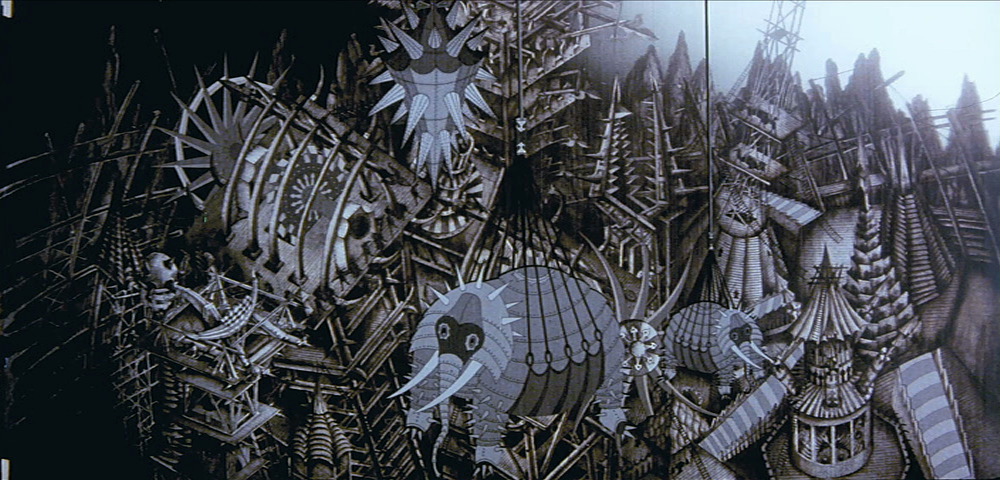 AS I said, I introduced Thursday’s program (commercials, movie title sequences and the short, The Little Island) with a short telling of how I first heard of Dick Williams, then came to meet him, work for him, befriend him and, finally, sit at a distance from him. Dick’s one of the more interesting personalities I’ve met in my life. He’s one of those few characters you get to know who lights up a room whenever he walks in. Energy just overflows the room, and everyone is happier for their presence. In all my years I’ve known possibly three people who filled this description, and it always was enriching for me. Bedazzling.
AS I said, I introduced Thursday’s program (commercials, movie title sequences and the short, The Little Island) with a short telling of how I first heard of Dick Williams, then came to meet him, work for him, befriend him and, finally, sit at a distance from him. Dick’s one of the more interesting personalities I’ve met in my life. He’s one of those few characters you get to know who lights up a room whenever he walks in. Energy just overflows the room, and everyone is happier for their presence. In all my years I’ve known possibly three people who filled this description, and it always was enriching for me. Bedazzling.
 The program included a number of sample reels from Dick’s Soho Square studio. Mostly humorous commercials, all excellently animated. I wish there had been some of the earlier ones mixed in; the Pushkin Vodka commercial shown was not the one I think of as genius; it was the 2nd of two spots they did. The original 2 minute spot was everywhere back in the 70′s; now you can’t see it. The film that was shown is well done but doesn’t soar like the original. Both were designed and animated by Rowland B. Wilson and Russell Hall; they did a bang up job on it. Several of the commercials animated by Eric Goldberg were among those screened; naturally they were funny pieces. There was the cat who uses 8 lives trying to get his hands on a beer product (can’t remember the brand). There was the baby, animated by Russell Hall, and his Q-tips commercial; done in a thick/thin line with watercolor. These are brilliant when compared to today’s live action babies speaking for E-trade.
The program included a number of sample reels from Dick’s Soho Square studio. Mostly humorous commercials, all excellently animated. I wish there had been some of the earlier ones mixed in; the Pushkin Vodka commercial shown was not the one I think of as genius; it was the 2nd of two spots they did. The original 2 minute spot was everywhere back in the 70′s; now you can’t see it. The film that was shown is well done but doesn’t soar like the original. Both were designed and animated by Rowland B. Wilson and Russell Hall; they did a bang up job on it. Several of the commercials animated by Eric Goldberg were among those screened; naturally they were funny pieces. There was the cat who uses 8 lives trying to get his hands on a beer product (can’t remember the brand). There was the baby, animated by Russell Hall, and his Q-tips commercial; done in a thick/thin line with watercolor. These are brilliant when compared to today’s live action babies speaking for E-trade.
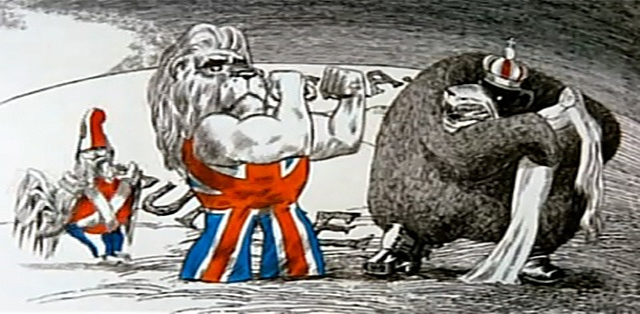 The spots turned into the title sequences for Charge of the Light Brigade. The print for this was significantly better than that of the commercials. This was followed by other title sequences including What’s New Pussycat?, and Return of the Pink Panther. No Murder on the Orient Express newspaper sequences with the glorious music by Richard Rodney Bennett; no Prudence and the Pill. I’ve always had a small problem with Williams’ work on title sequences. It’s hard to read the titles/credits on display. That’s the purpose of the job, and yet the type is always at war with what’s behind it. It’s all beautifully, no . . . brilliantly done. Except for that legibility problem.
The spots turned into the title sequences for Charge of the Light Brigade. The print for this was significantly better than that of the commercials. This was followed by other title sequences including What’s New Pussycat?, and Return of the Pink Panther. No Murder on the Orient Express newspaper sequences with the glorious music by Richard Rodney Bennett; no Prudence and the Pill. I’ve always had a small problem with Williams’ work on title sequences. It’s hard to read the titles/credits on display. That’s the purpose of the job, and yet the type is always at war with what’s behind it. It’s all beautifully, no . . . brilliantly done. Except for that legibility problem.
This show ended with the half hour long The Little Island. A very good print, this was the short Dick did virtually by himself with the help of Tristram Cary‘s strong musical score. The film is at least twice the length it should be, and feels somewhat dated. However, one can understand its success when it was originally screened at the early animation Festivals where it won many awards and brought Dick Williams some fame.
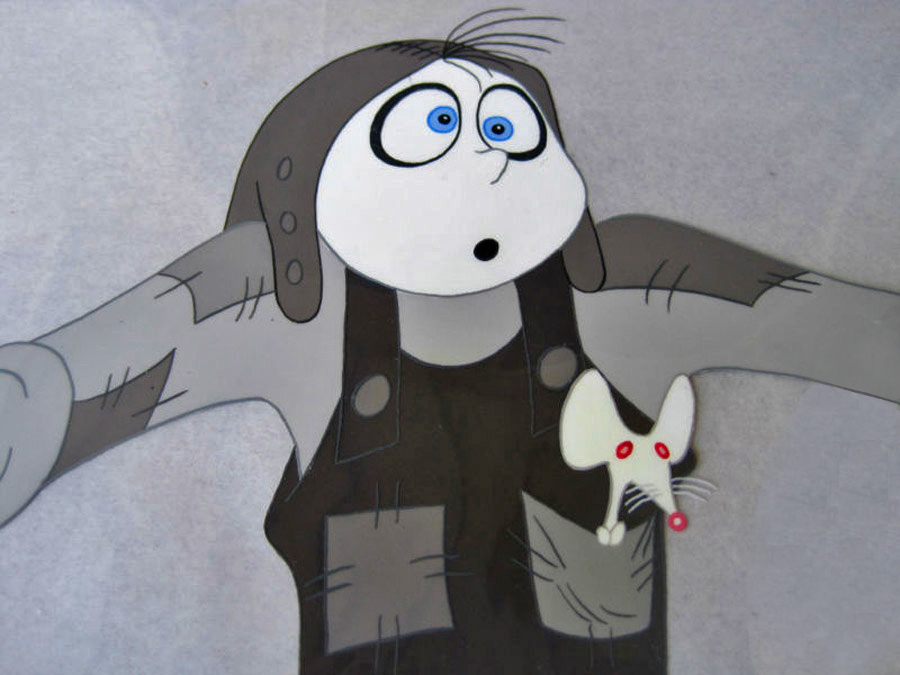 Then last night we saw Kevin Schreck‘s documentary, Persistence of Vision. This was the story behind Dick’s feature, The Thief and the Cobbler. A 70 minute tour back through more than a decade’s worth of history on the making of an animated feature that never really was completed. Some patches and staples were added at the end so it could be released in the most shameful way possible, but that’s the way Dick’s “master piece” ended up.
Then last night we saw Kevin Schreck‘s documentary, Persistence of Vision. This was the story behind Dick’s feature, The Thief and the Cobbler. A 70 minute tour back through more than a decade’s worth of history on the making of an animated feature that never really was completed. Some patches and staples were added at the end so it could be released in the most shameful way possible, but that’s the way Dick’s “master piece” ended up.
Not all of the footage in the documentary was of the best quality. Some of the shots were a bit on the dark side. The information passed on was wholly there, though. Very good. The film gives us interviews with a number of truly fine artists. Roman Modiano, Richard Brett, Greg Duffell, Julianna Franchetti all spoke with Schreck’s camera about their history and involvement with Williams feature. They paint a relatively positive pickture of Dick Williams, though somehow bits of his blustery side come across clearly.
The film only barely touches on Omar Ali-Shah‘s financial games on Dick’s studio. He cooked the books, and didn’t do a very good job of it. Everyone was aware of his discrepencies. A hurtful separation with the Idres Shah (Omar’s brother) who wrote the book on Nasrudin which Dick had illustrated and was now animating as an animated feature. They left with any permission to do a feature starring their character. Dick had to completely overhaul his animated feature and rework the script as well as most of the completed animation. A setback.
The Thief and the Cobbler emerged, and Dick worked his tail off, destroying several marriages in the way of his work. He worked through The Christmas Carol, Raggedy Ann, Ziggy and Roger Rabbit all in pursuit of financial stability. He finally got the budget he asked for to produce The Thief, and sure enough, it wasn’t sufficient. Dick ran out of money without completing the movie, and the insurance company, the Completion Bond Co, was forced to step in and take possession of Dick’s movie, which now belonged to the Completion Bond Co. They hired 2nd rate all the way to rework the film, trying to make what they felt would be a success out of it. A friend who was a final checker on the movie, had to visit the morgue for drawings that could be reused. She came upon a mass of broken and crushed boxes with artwork spilling out covering the warehouse’s entire cemnt floor. This was the artwork that took many hours to color since its rendering was so delicately done in England.
 That, to me, was the sad ending. Tissa David had worked for more than a year animating the twin sisters, Yum Yum and her twin sister, Mee Mee. Tissa was left behind, and Dick cut Mee Mee from the film, reworking some of Tissa’s animation. I sat next to Tissa watching the Fred Calvert version of the film; I was aghast. Tissa was quietly sad as if a friend had died. It was a bit reminiscent of our watching Watership Down together after Hubley had been fired and had died of heart complications. We both cried during the “Bright Eyes” sequence of that film. Watchya gonna do?
That, to me, was the sad ending. Tissa David had worked for more than a year animating the twin sisters, Yum Yum and her twin sister, Mee Mee. Tissa was left behind, and Dick cut Mee Mee from the film, reworking some of Tissa’s animation. I sat next to Tissa watching the Fred Calvert version of the film; I was aghast. Tissa was quietly sad as if a friend had died. It was a bit reminiscent of our watching Watership Down together after Hubley had been fired and had died of heart complications. We both cried during the “Bright Eyes” sequence of that film. Watchya gonna do?
Kevin Schreck captured the feeling of that film -The Thief and the Cobbler, I mean -in all its disappointment. He’s a young film maker, and seems to have caught Dick Williams in this documentary. That’s plenty.
Ursus
Signe Baumane shared this film with me yesterday; a friend of hers in Latvia. had sent it to her, and she wanted to see what I thought. The film went to Clermont Ferrand and 70 other festivals. It’s a real beauty and I couldn’t help but share it with you. I hope you enjoy it as much as I did.
Crood History
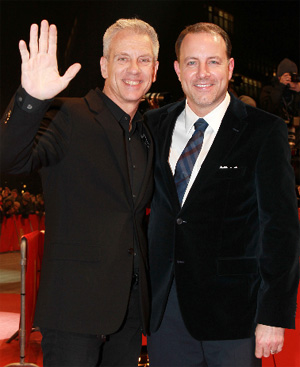 Jim Hill has a piece in The Huffington Post about The Croods talking about its history – when it was to be done by Aardman and was co-authored by John Cleese. How and why it’s changed is revealed in this article.
Jim Hill has a piece in The Huffington Post about The Croods talking about its history – when it was to be done by Aardman and was co-authored by John Cleese. How and why it’s changed is revealed in this article.
Though in one sweeping sentence Hill says, “… Aardman Animations stepped away from its five-picture deal with DreamWorks Animation.” I question whether that’s what happened and if it can be so casually dismissed for the purpose of this puff piece. But it’s Jim Hill, so we’ll not get a full story.
Pictured to the right The Croods directors, Chris Sanders and Kirk DeMicco.
Speaking of Dreamworks, they are performing a “crood” measure. They’ve promised to lay off some 350 of their 2200 employees by the end of the year. I doubt this has anything to do with what is happening in Washington, but certainly that isn’t helping. Perhaps Katzenberg can help get some of the idiots in congress to “lose their jobs” by 2014. Maybe that’d help our economy. This news of the layoffs came from a Hollywood Reporter story and really has all to do with the poor performance of The Rise of the Guardians.
Animation &Commentary &Daily post &Errol Le Cain &Richard Williams 25 Feb 2013 05:28 am
POV
Next Friday, at the invitation of filmmaker-editor-director, Kevin Schreck, I’ll have the pleasure of seeing his recently completed documentary, Persistence of Vision. This is the story of the making of Richard Williams‘ many-years-in-the -making animated feature, The Cobbler and the Thief. I’m not sure of the film maker’s POV, but I somehow expect it to be wholly supportive of the insistent vision of Richard Williams in the making of this Escher-like version of an animated feature. A work of obsession.
It’s the tale of an “artist”, someone who sees himself as an artist, and continually pushes through the world with what would seem to be evident proof of such. After all, this man had single-handedly altered the face of 2D animation in a world that was about to throw it away with all its rich history and artistry and strengths. A medium that had developed through the years of Disney with giant, filmed classics such as Snow White, Pinocchio, Fantasia and even Sleeping Beauty. A medium that had drastically changed to 20th century graphics under the hands of people like John Hubley, Chuck Jones, George Dunning and many others and had just about reached a zenith where it was moving toward something wholly new, something adult.
Instead the medium took a turn in the wrong direction. The economics of television brought us back almost 100 years as films became more and more simplistic and simpleminded in the rush to be cheap. Even the Disney studio went for the poorest subject matter using cost-saving devices to sell their films. Films became shoddier and shoddier, and the economics ruled. The closest the medium would come to art was Ralph Bakshi‘s Fritz the Cat and Heavy Traffic, low budget movies that traded on racy material in exchange for an attempt at something adult, stories barely held together with editing tape. Animation was getting a bad name from every corner whether it was the sped-up graphics of Hanna-Barbera, the reach to the lowest common denominator with poor animation from Disney, or the shock and tell of Ralph Bakshi‘s filmed attempts at what he saw as art.
Williams took a different turn. He went back to the height of animation’s golden era, inviting artists such as Grim Natwick, John Hubley, Ken Harris and Art Babbitt to his London studio to lecture on the rules and backbone of the animation. He brought some of these people to work on a feature that he’d decided to create within his studio on the profits of commercials. These very same commercials financed the training of Dick and his young staff.
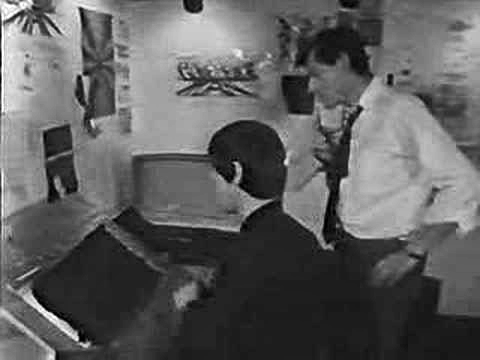 A documentary done in 1966, called The Creative Person: Richard Williams offers an excellent view of his studio. We see snippets of shorts Dick made with his own coin: Love Me Love Me Love Me (1962) or The Sailor and the Devil (1967) wherein we see the training of a young and brilliant illustrator named Errol le Cain. (Le Cain became known for his magnificent, glimmering children’s book illustrations. He was doing most of the backgrounds for The Cobbler and the Thief, and had certainly had a large part in its design.)
A documentary done in 1966, called The Creative Person: Richard Williams offers an excellent view of his studio. We see snippets of shorts Dick made with his own coin: Love Me Love Me Love Me (1962) or The Sailor and the Devil (1967) wherein we see the training of a young and brilliant illustrator named Errol le Cain. (Le Cain became known for his magnificent, glimmering children’s book illustrations. He was doing most of the backgrounds for The Cobbler and the Thief, and had certainly had a large part in its design.)
 We see in this documentary the first hint of The Cobbler when it was called Nasruddin. It was based on a book of middle eastern tales of a wise fool whose every short story tells a new and positive anecdote. Dick had illustrated several books of these tales with many funny line drawings. The book was written by the Idres Shah who had undertaken a role within the Willams studio finding funds for the feature. Eventually, the two had a falling out, and Idres Shah left with his property. Williams took the work he had done as Nasruddin and reworked it into The Cobbler and the Thief. ________________________________Errol le Cain
We see in this documentary the first hint of The Cobbler when it was called Nasruddin. It was based on a book of middle eastern tales of a wise fool whose every short story tells a new and positive anecdote. Dick had illustrated several books of these tales with many funny line drawings. The book was written by the Idres Shah who had undertaken a role within the Willams studio finding funds for the feature. Eventually, the two had a falling out, and Idres Shah left with his property. Williams took the work he had done as Nasruddin and reworked it into The Cobbler and the Thief. ________________________________Errol le Cain
Meanwhile the work within his studio continued to develop, growing more and more mature. The commercials became the highlight of the world’s animation. Doing many feature film titles such as What’s New Pussycat (1965), A Funny Thing Happened on the Way to the Forum (1966), The Charge of the Light Brigade (1968) led to Dick’s directing a half-hour adaptation of The Christmas Carol (1971). Chuck Jones produced the ABC program, and it led to an Oscar as Best Animated Short.
Through all this The Cobbler and the Thief continued. Many screenplays changed the story and the stunning graphics that were being produced for that film were often shifted about to accommodate the new story.
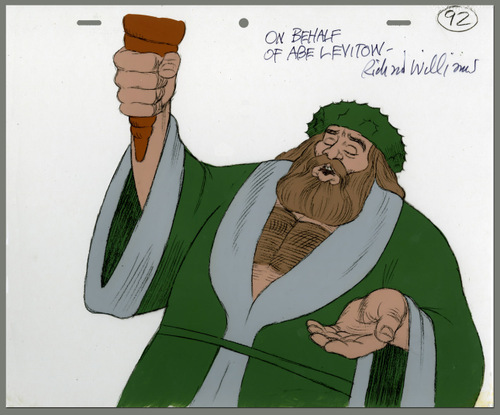 By this time, Williams had developed something of a name within the world of animation. Strong and important animation figures went to his studio to work for periods of time. Someone like Abe Levitow taught and animated for the studio. (His scenes for The Christmas Carol are among the most powerful.) Many of the Brits that worked in the studio and then left to start their own companies were now among the world’s best animators.
By this time, Williams had developed something of a name within the world of animation. Strong and important animation figures went to his studio to work for periods of time. Someone like Abe Levitow taught and animated for the studio. (His scenes for The Christmas Carol are among the most powerful.) Many of the Brits that worked in the studio and then left to start their own companies were now among the world’s best animators.
Williams had the opportunity of doing a theatrical feature adaptation of the children’s books The Adventures of Raggedy Ann and Andy and took it. A large staff of classically trained animation leaders such as Art Babbitt, Grim Natwick, Tissa David, Hal Ambro, Emery Hawkins and many others worked out of New York or LA as the company set up two studios to produce this film. Working for over two years, Dick’s attention was diverted to work away from his London studio, where commercials and some small devotion was given to The Thief by a few of the key personnel working there. Dick spent a good amount of his time in the air flying from NY to LA to NY to London and back again and again. He concentrated his animation efforts on cleaning up animation by some of the masters, rather than allow proper assistants to do these tasks. By doing this he was able to reanimate some of the work he didn’t wholly approve of. Entire song numbers were reworked by Dick as the film flew well behind its budget and schedule.
Eventually, the film finished in confusion and mismanagement, and Dick moved to his LA studio where he continued commercials and began Ziggy’s Gift, a Christmas Special for ABC.
 From this he went back to his London studio and did the animation for Who Framed Roger Rabbit for producer/director Robert Zemeckis. He hoped that work on this feature, which won three Academy Awards, including a special one for the animation, would be the triumph he needed to help him raise the funds for The Thief and the Cobbler. Now that he was safely back in his own studio in Soho Square he felt more focused.
From this he went back to his London studio and did the animation for Who Framed Roger Rabbit for producer/director Robert Zemeckis. He hoped that work on this feature, which won three Academy Awards, including a special one for the animation, would be the triumph he needed to help him raise the funds for The Thief and the Cobbler. Now that he was safely back in his own studio in Soho Square he felt more focused.
A contract came from Warner Bros., and the work began in earnest.
Dick’s history wasn’t the best working on these long form films. Chuck Jones replaced him on The Christmas Carol to get it finished when work went overbudget and schedule. Dick was putting too much into it. Gerry Potterton finished Raggedy Ann when the budget went millions over with less than a third completed. Eric Goldberg took over Ziggy’s Gift, the Christmas Special for ABC, to get it done on time. On Roger Rabbit, the live action director stayed intimately involved in the animation after his shoot was complete. When it became obvious that things weren’t going well, he stepped in to complete that film.
In all cases of all of these films, Dick never left. He stayed on working separately on animation or assisting to try to keep a positive hand in the quality of the work that was done.
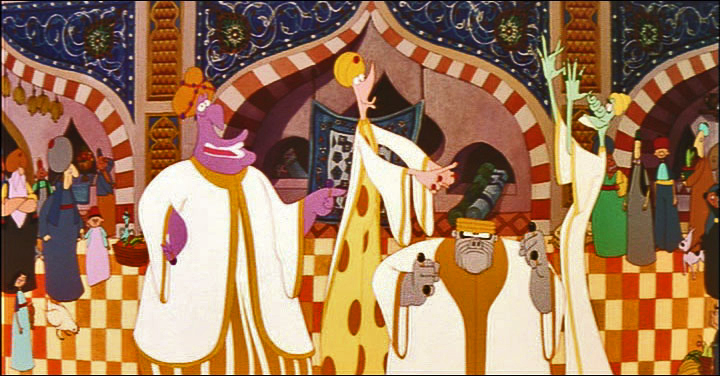 When The Cobbler and the Thief ran into very serious trouble, there was no secondary Director or Producer to come in and complete the work. Instead that job fell to the money men. The completion bond company, essentially an insurance company for Warner Bros. to make sure they wouldn’t lose their money if things didn’t go well, stepped in. They closed Dick’s studio and removed Dick from the premises. The boxed up and carted off all animation work done or in progress. It was all moved back to Los Angeles.
When The Cobbler and the Thief ran into very serious trouble, there was no secondary Director or Producer to come in and complete the work. Instead that job fell to the money men. The completion bond company, essentially an insurance company for Warner Bros. to make sure they wouldn’t lose their money if things didn’t go well, stepped in. They closed Dick’s studio and removed Dick from the premises. The boxed up and carted off all animation work done or in progress. It was all moved back to Los Angeles.
The Weinsteins, through their company, Miramax bought the film at auction and completed it with a poor excuse of an animation outfit they set up in LA. Work was also sent to Taiwan. The script was reworked trying to capitalize on the success of Disney’s Aladdin that had recently opened in the US. If Robin Williams‘ ad libbing could be such a success, imagine how well Jonathan Winters could do repeating that for a character who, in Dick’s original version, had no voice. Now he didn’t stop talking.
The new film failed miserably and deserved to do so. The primary audience, I would suspect, was the entire world animation community coming to look down on the artificially breathing corpse.
 Richard Williams, himself, retired and moved far from the mainstream. He continues to work on small animation bits, but his primary work has been in making a series of DVD lectures revealing how animation should be done. This accompanies a well-received book he wrote and illustrated. Meanwhile, the animation community still hopes that something will emerge from that corner.
Richard Williams, himself, retired and moved far from the mainstream. He continues to work on small animation bits, but his primary work has been in making a series of DVD lectures revealing how animation should be done. This accompanies a well-received book he wrote and illustrated. Meanwhile, the animation community still hopes that something will emerge from that corner.
Dick turns 80 years old on March 19th. He’s still an amazing forceful and exciting personality. I wish I had more access to him (as does most of those who knew him back then.) He’s had probably the greatest effect on the animation industry of anyone since the late sixties. There are still studios thriving today on information they learned from Dick and his teaching.
If you’re unfamiliar with the blog, The Thief, I suggest you take a look.
Commentary 25 Feb 2013 01:15 am
Oscars Stink
It was a long boring show. Seth McFarlane never got the appropriate timing for the joke telling and consequently blew every joke. He should stay behind the animation joke telling.
Congratulations to the makers of Brave and Paperman. Both are distinguished films, and now they’re more distinguished. Both are solid performances.
Congratulations to the EFFX people who did Life of Pi. I’m embarrassed that the Academy treated you so poorly wen giving a not-very-long speech. Especially in the light of the words you were about to say re the labor problems Rhythm & Hues is having. I can’t believe they shut off your mic. Such poor taste makes one wonder about the dignity of the show’s producers. It didn’t come off as very gracious, to say the least.
I won’t say bad about Argo, I’ll only think it. I’m pleased Ang Lee won Best Director and received a well deserved standing ovation.
On to 2013. Hopefully there will be more dignity in the end.
Commentary &SpornFilms 24 Feb 2013 04:39 am
Jabberwocky
- To me, Lewis Carroll‘s nonsense poem, Jabberwocky, is one of the most brilliant pieces ever written. It’s always been important to me, and I’ve collected many versions of it in illustrated versions.
I’d like to post here a few of the images from my short adaptation of the Lewis Carroll poem, Jabberwocky. In doing the film, I tried to mimic a style I’d used in my oil paintings and felt it was a bit successful. I don’t think the filmed version is all it could be – it was rushed to complete a package which included the 19 min. film, The Hunting of the Snark, as well as an animated documentary done about Lewis Carroll’s nonsense poems. Of course, the video package wouldn’t have made sense without including Jabberwocky.
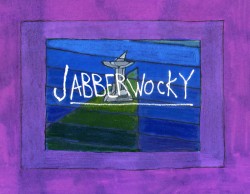
(click any image to enlarge.)
But I’ve scanned these images from the actual artwork and realize how well they’ve held up. I’d like to redo the film digitally someday and see where I can go with it.
Here are some of the images:
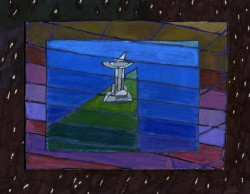

‘Twas brillig and the slithy toves,
Did gyre and gimble in the wabe;
All mimsy were the borogoves,
And the mome raths outgrabe.
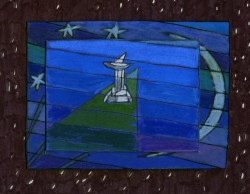

“Beware the Jabberwock, my son!
The jaws that bite, the claws that catch!â€
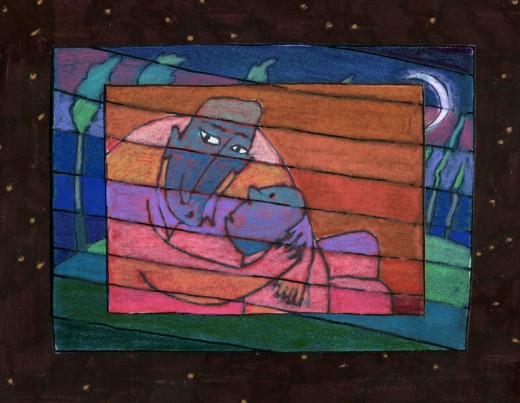
“Beware the Jubjub bird, and shun
The frumious Bandersnatch!â€

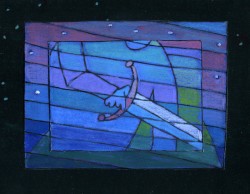
He took his vorpal sword in hand;
Long time the manxome foe he sought -
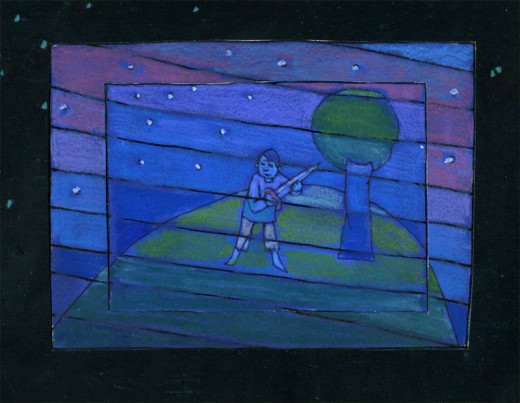
So rested he by the Tumtum tree
And stood awhile in thought.

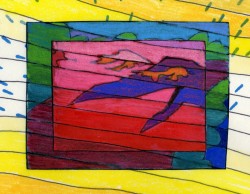
And as in uffish thought he stood,
The Jabberwock, with eyes of flame,


Came whiffling through the tulgey wood,
And burbled as it came!
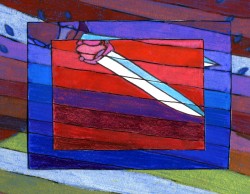
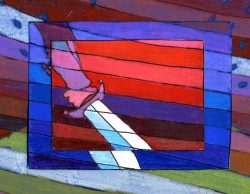
One, two! One, two! And through and through

The vorpal blade went snicker-snack!
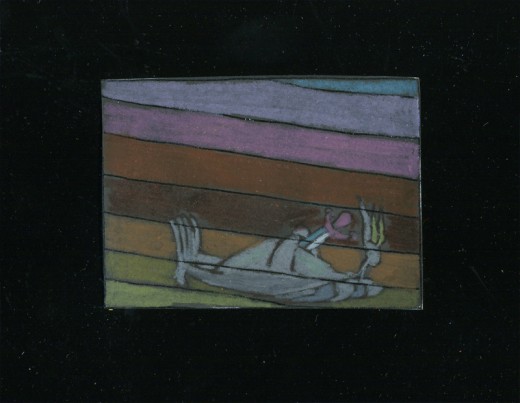
He left it dead, and with its head
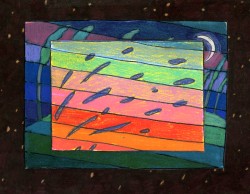
“And hast thou slain the Jabberwock?
Come to my arms, my beamish boy!
O frabjous day! Callooh! Callay!â€
He chortled in his joy.
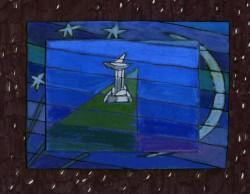
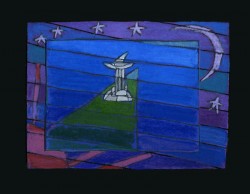
‘Twas brillig and the slithy toves
Did gyre and gimble in the wabe;
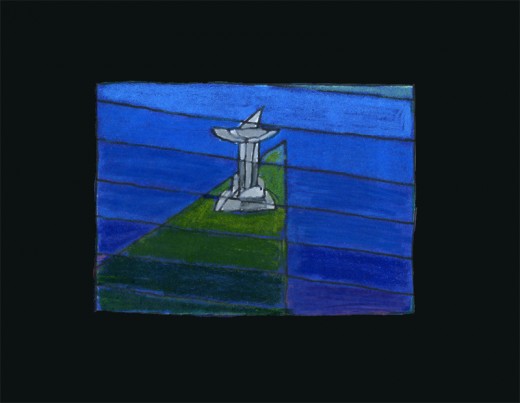
All mimsy were the borogoves,
And the mome raths outgrabe.
______________________
In other film versions, you have the one live action feature by Terry Gilliam; it’s a good film with a clunky monster in the end. In animation, professionally, I know of only two versions completed. One was by Jan Svankmajer done in 1974. I did a version of it in 1989. Mine, of course, sticks closer to the poem even though it is pretty “arty”.
 Apparently, there was also a version Disney was preparing as part of Alice In Wonderland. A book was published, credited to the “Disney Archives,” with illustrations from the preparatory drawings of this sequence. It’s obvious that the final versions of these drawings were done by one person, but there’s no record in the book of who did the finals.
Apparently, there was also a version Disney was preparing as part of Alice In Wonderland. A book was published, credited to the “Disney Archives,” with illustrations from the preparatory drawings of this sequence. It’s obvious that the final versions of these drawings were done by one person, but there’s no record in the book of who did the finals.
I’m not in love with the images in the book, and I know I would have hated the animated version (especially if it looked like this.) They’re trying too hard to make sense of the poem. I find the images too cute, though, it’s amazing how current they look.
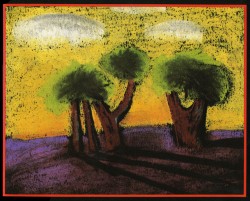
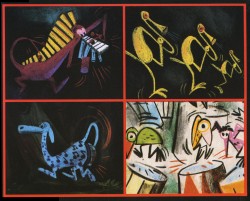
‘Twas brillig and the slithy toves
Did gyre and gimble in the wabe;
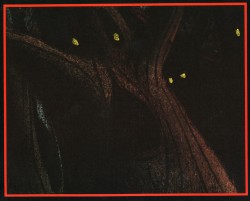
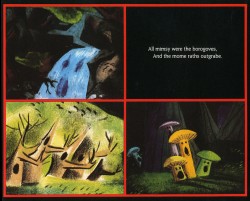
All mimsy were the borogoves,
And the mome raths outgrabe.
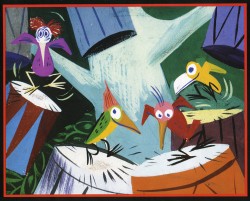
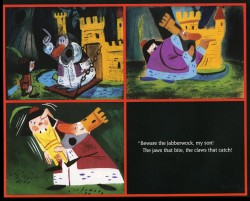
“Beware the Jabberwock, my son!
The jaws that bite, the claws that catch!”

“Beware the Jubjub bird, and shun
The frumious Bandersnatch!”
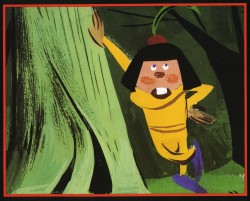
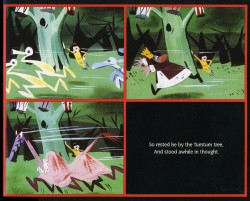
He took his vorpal sword in hand;
Long time the manxome foe he sought -
So rested he by the Tumtum tree
And stood awhile in thought.
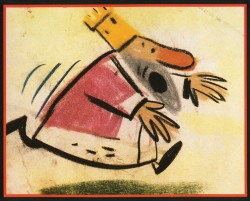
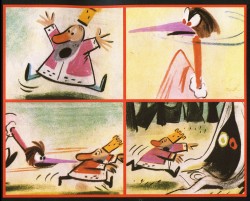
And as in uffish thought he stood,
The Jabberwock, with eyes of flame,
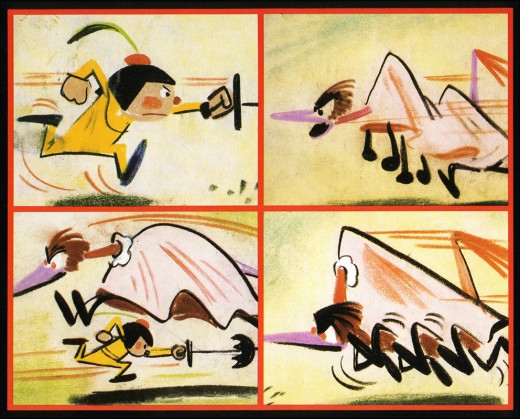
Came whiffling through the tulgey wood,
And burbled as it came!
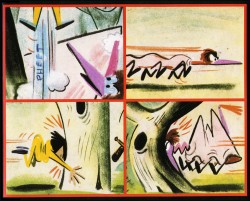
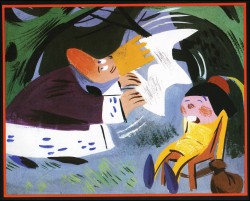
One, two! One, two! And through and through
The vorpal blade went snicker-snack!
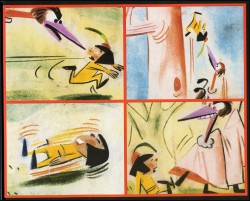
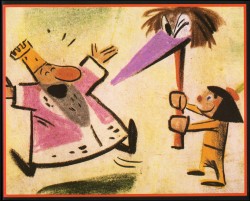
He left it dead, and with its head
He went galumphing back.
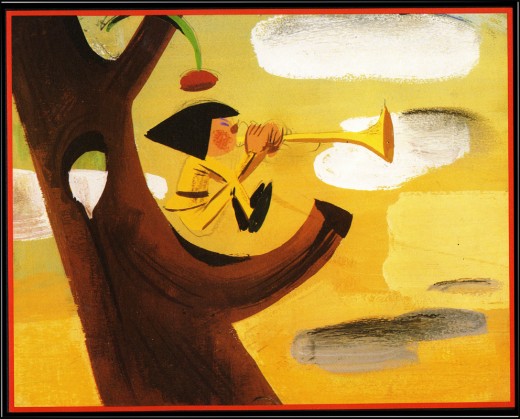
“And hast thou slain the Jabberwock?
Come to my arms, my beamish boy!
O frabjous day! Callooh! Callay!”
He chortled in his joy.
(Boy, do I like my version better! – MS)
Jim Hill writes a bit about this book on his site in a letter response. here. (Scroll down to middle of page.)
For amusement, you might check out this site for translations of this poem into 58 other languages, 23 parodies of the poem, and 10 explanations trying to define what Carroll meant by it.
Commentary 23 Feb 2013 04:58 am
Awardios
– There wasn’t a hell of a lot that happened in animation in the past week. True, we do have the Oscars coming up on Sunday, and it’ll be interesting to see which of the features nominated will win. Though, I have to admit I’m not charged by any of the animated entrees this year. What I am excited by is the live action film Life of Pi. I will be watching closely to see how many awards this “live action” film will win. The politics of Argo may cause a mini-upset with that film winning the big award. That’d be disappointing, and I hope it won’t be true. The film is not a great one; in fact, I’m not sure I’d even call it good. (It’s a heightened film with TV type dramatics. That race through the airport with the Iranian olice driving on the airfield is particularly offensive.) I’d be happier if Lincoln won the award. At least the film is, for the most part, honest.
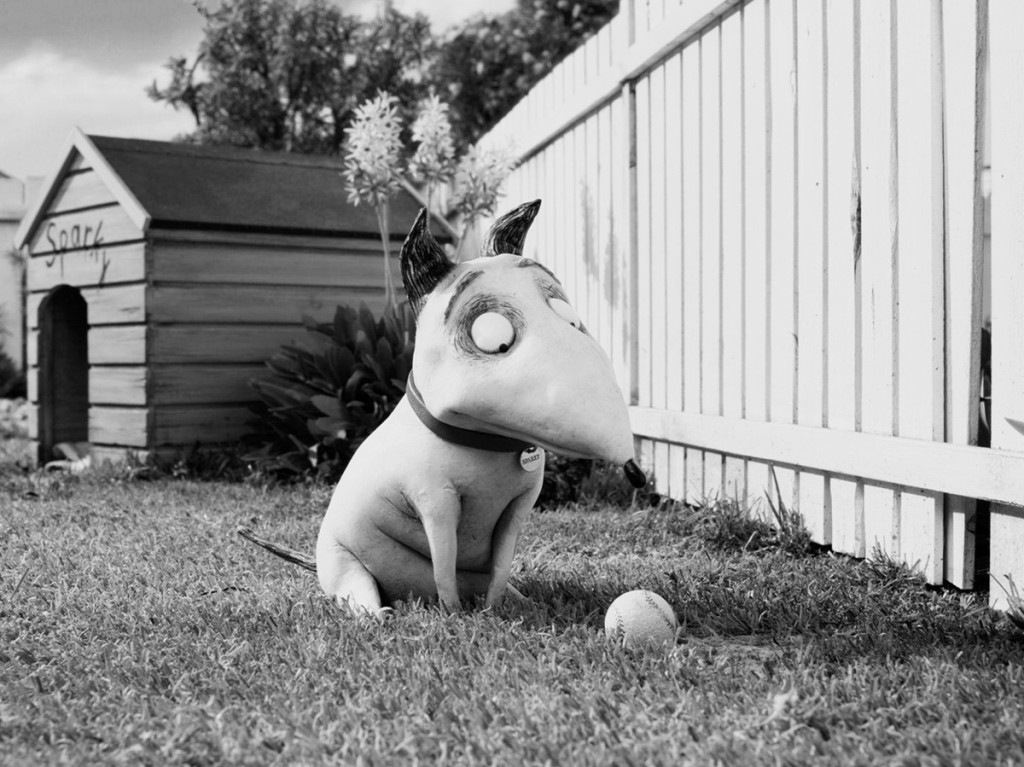 As for the animated feature films nominated, Wreck It Ralph seems to have more critics pushing for it; after about 20 minutes into the film, I felt like I wasn’t going to get much more out of it – I was emotionally detached, to say the least. I’ve seen more promotional ads for ParaNorman than for the other films. I’d expected Brave to have been loudest searching for attention. Personally, I didn’t find any of the films great, but felt closest to Frankenweenie even though I love Aardman’s work on The Pirates!.
As for the animated feature films nominated, Wreck It Ralph seems to have more critics pushing for it; after about 20 minutes into the film, I felt like I wasn’t going to get much more out of it – I was emotionally detached, to say the least. I’ve seen more promotional ads for ParaNorman than for the other films. I’d expected Brave to have been loudest searching for attention. Personally, I didn’t find any of the films great, but felt closest to Frankenweenie even though I love Aardman’s work on The Pirates!.
As for the shorts, there seems to be another toss-up going on. I kind of think that Paperman has an advantage over the others. It got started promoting itself long before the nominations, so everyone knows about it. Then there have been those many versions of the cgi film that have 2D drawings animating on top of them. I don’t quite get the process. The videos make it look like only the hair and secondary bits were animated by 2D/hand. Is that the case? Why couldn’t that have been done in cgi. Especially after we see how stunning the hair in Brave has been done? Just count me out on this as ignorant.
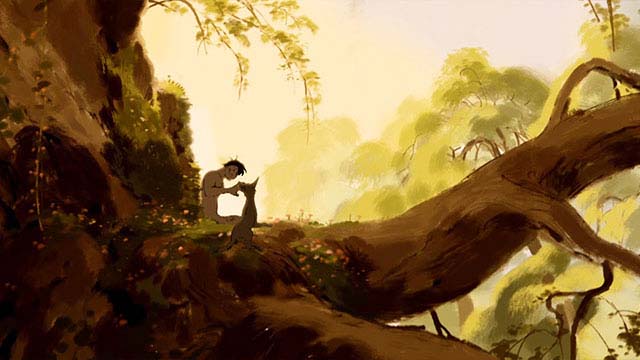 Adam and Dog has my favorite animation. More than half the animators I know are bothered by the “Christian” message in the film. I still miss that. Adam & Eve is such folklore that I can’t even push it mentally into anything religious. Regardless,, the dog stays away from that story pretty much. We, the audience, have additional information than has the dog, so we understand why Adam leaves him for awhile and also why Adam returns “after the fall”. This is all irrelevant to the dog, and I love that part of it. I’d vote for this just for the beautiful animation and graphics. Great backgrounds. It was a hard piece to pull off.
Adam and Dog has my favorite animation. More than half the animators I know are bothered by the “Christian” message in the film. I still miss that. Adam & Eve is such folklore that I can’t even push it mentally into anything religious. Regardless,, the dog stays away from that story pretty much. We, the audience, have additional information than has the dog, so we understand why Adam leaves him for awhile and also why Adam returns “after the fall”. This is all irrelevant to the dog, and I love that part of it. I’d vote for this just for the beautiful animation and graphics. Great backgrounds. It was a hard piece to pull off.
Head Over Heels is about a man and woman at odds with each other. One walks on the ceiling of their apartment, the other on the floor. They’re always banging into each other and always in the way. For me, the metaphor also keeps getting in the way, and once I got the problem, I still had to get through the rest of the movie, while I waited for them to get over the problem.
Fresh Guacamole uses things like dice and golf balls and handgrenades to represent the makings of guacamole. This is like many other pieces PES has animated, and I sort of want something new.
The Longest Daycare, the Simpsons film is just that. It’s no funnier than anything I’ve seen on the TV show (in a good week), so I don’t understand what makes it a theatrical – except that they’re showing it in theaters.
It’s interesting that these shorts are tied together and released theatrically according to a story I’ve read on Yahoo. However, the shorts’ filmmakers have all put them online for free. They’ve been asked by an “Academy affiliate” to take them down so that they don’t compete with themselves for the theatrical tickets which are sold. I guess it’s become a dilemma for the filmmakers. Personally, I’d keep my short off line for some time. You lose a lot of revenue if you’re always competing with yourself. If you win the Oscar, you’re losing a lot of cash and prestige.
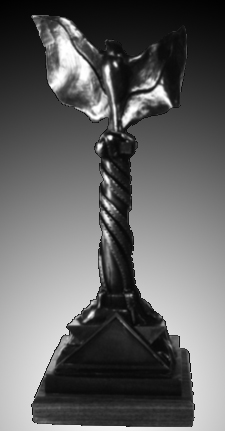 I’ve always found it curious that the Independent Spirit Awards, which take place one day earlier than the Oscars and are designed to celebrate Independent motion pictures rarely honor any animated films with a nomination. When Nina Paley distributed the self-financed Sita Sings the Blues, she won every major Independent Award at every Festival, yet she received the ONLY nomination, ever, from the Independent Spirit Awards that I can remember. “The Someone to Watch” nominaton. Not Best Film, not Best Animated Film or Best Direction. Not Best sound or score or . . . Only the “Someone to Watch” nomination.
I’ve always found it curious that the Independent Spirit Awards, which take place one day earlier than the Oscars and are designed to celebrate Independent motion pictures rarely honor any animated films with a nomination. When Nina Paley distributed the self-financed Sita Sings the Blues, she won every major Independent Award at every Festival, yet she received the ONLY nomination, ever, from the Independent Spirit Awards that I can remember. “The Someone to Watch” nominaton. Not Best Film, not Best Animated Film or Best Direction. Not Best sound or score or . . . Only the “Someone to Watch” nomination.
Bill Plympton has done ten films that have all had budgets lower than the lowest (not that Independence has anything to do with the budget), have been distributed independently – out of Bill’s apartment – and have been very limited in the scope they’ve been able to achieve. Yet not one nomination for anything. Persepolis – no nominations. Watching for Bahir – no nominatons. Rango – nothing. It would seem to me that the Independent Live Action Filmmakers are treating our medium with a good deal of disrespect.
and They’re Off . . .
Next year’s awards already seem to be up and running animation-wise. At least as far as the features are concerned. Dreamworks‘ film, The Croods has been accepted into the 16th Holland Animation Film Festival, and will act as the closing night film. I’m not sure what that means since I haven’t yet been to that Festival (although it always sounds like a good one.) The Fest runs from 20-24 March 2013 and will take place in Utrecht, a beautiful town.
For information in the Festival go here: 16th Holland Animation Film Festival.
Competing with The Croods, of course, is The Weinstein Company’s Escape from Planet Earth which grossed a robust $21.1 million over the four-day President’s Day holiday weekend. I’m sure the quality of this film is at least as good as was Hoodwinked.
R.I.P. Bob Godfrey
Amid Amidi reported today that Bob Godfrey had passed away last night, Thursday 21st February 2013, in his sleep. He was 91 years old. There’s a nicely knowing piece about his early days in British animation printed in the Guardian.
My single memory of Bob in person goes back to the Ottawa Animation Festival in 1980. Bob, who often did slightly risque films, had brought a film called Dream Doll to the Festival, to which he was also a judge. You can imagine what Dream Doll was about, and I’ll agree with you.
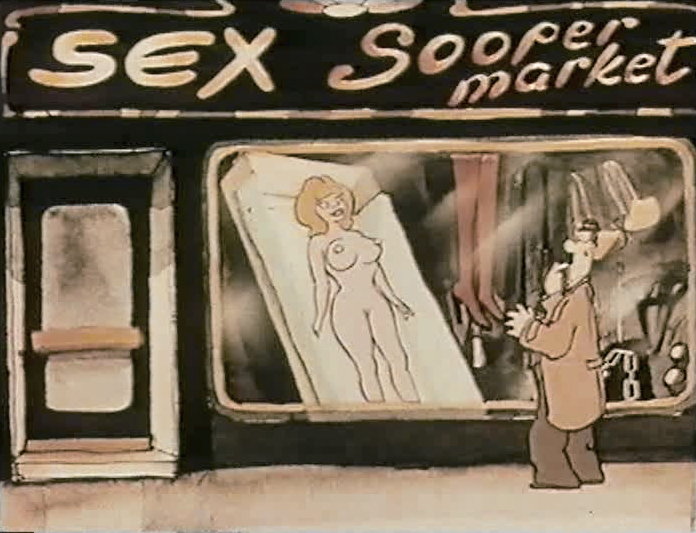 It was one of those slightly rainy Festivals, but it was fun just the same. At the picnic, we were right near a government building, as I remember. Someone surprised Bob with a real “Dream Doll.” a female balloon, as naked as the one in the cartoon. There was, at first, lots of laughter; then there was screaming, shouting protests from those trying to protect females everywhere. We tried to explain the situation to the animator who hadn’t seen the animation, but it ended with an ice pick. The naked balloon withered qucikly, as did the laughs.
It was one of those slightly rainy Festivals, but it was fun just the same. At the picnic, we were right near a government building, as I remember. Someone surprised Bob with a real “Dream Doll.” a female balloon, as naked as the one in the cartoon. There was, at first, lots of laughter; then there was screaming, shouting protests from those trying to protect females everywhere. We tried to explain the situation to the animator who hadn’t seen the animation, but it ended with an ice pick. The naked balloon withered qucikly, as did the laughs.
It’s funny, but I can’t go to the Festival in Ottawa without remembering that Bob Godfrey story. It was five years earlier that he had won his Oscar for Great (a film I didn’t enjoy as much as I did Dream Doll, but I was glad he had a trophy to take through the rest of his life.
Bob Godfrey was part of the Grasshopper Group, a short-lived movement in British animation in the late Fifties, early Sixties. It was named after an Anson Dyer character from the silent era. Norman McLaren was appointed President. Kenneth Clarke, teamed with John Daborne with Gerald Potterton and Godfrey. Over the years, Derek Hill, Jim Nicolson, John Kirby, Stuart Wynn Jones, Richard Horn, Kevin Brownlow were all members with comedian Peter Sellars eventually replacing McLaren as the group’s President. Richard Williams also worked through the group for a short time as did Stan Hayward who wrote for Williams on a number of early shorts. Many of the group worked together for years and all remained friends for life.
Godfrey really got a name for himself in Britain after setting up his studio, Bob Godfrey Movie Emporium, and doing a very popular TV series, Roobarb.
There’s an excellent obit for Godfrey in the Independent.
Kickstarter Bakshi
Things have gotten interesting for The Last Days of Coney Island, the Ralph Bakshi series of shorts for which he’s trying to raise $165000. It’s a Kickstarter campaign; with 8 more days to go, the producer/director has raised almost $127000, making it very possible. 8 more days to go. Please look into it and give if you have anything to offer.
The brilliant illustrator, Ian Miller has committed to the project as has the actor, Matthew Modine. A list of other future employees have been announced on the Kickstarter site. Only one more week for these guys to put together something interesting. Check it out.
On the Mark and Back to the Blog
Mayerson on Animation. Finally one last thing to note. For those Mark Mayerson junkies out there, he’s back to his blog. A bit more than a month ago, Mark broke his wrist and his blog had been on hiatus until yesterday. He’s shed a cast and will probably come back to the site slowly. For my taste, he can be as slow as he needs to be. Any bit of Mark, reviews or commentary or reportage; it’s all good, and I’m glad to keep checking in.
Books &Commentary &Disney 19 Feb 2013 05:17 am
Jim Korkis’ Song of the South
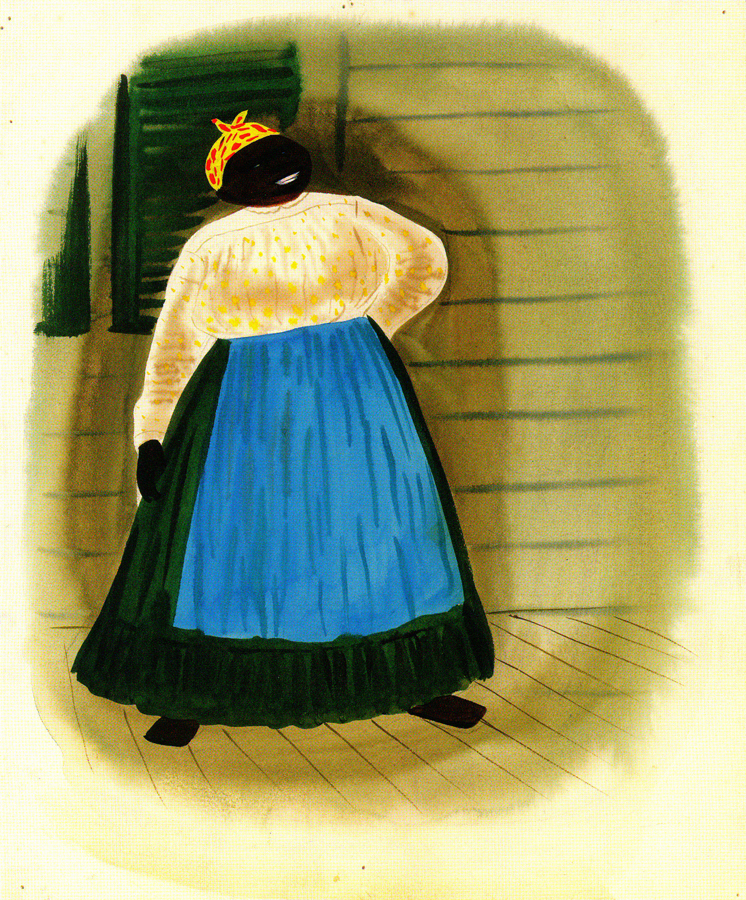 As the War came to an end, Walt Disney realized that he needed to find a way to raise money for his movies or, at the least, make films more profitably. One idea he chose to employwas to make more live action film.
As the War came to an end, Walt Disney realized that he needed to find a way to raise money for his movies or, at the least, make films more profitably. One idea he chose to employwas to make more live action film.
He’d had some modest success with The Three Caballeros and Saludos Amigos by combining live action and animation.
For years he’d thought of doing a combination film with Alice In Wonderland placing a live action Alice in an animated world, not unlike the early silent films Alice in Cartoonland.
Disney also thought of going to the stories of Joel Chandler Harris. By making the story of the humans in live action and the stories of Br’er Rabbit, Br’er Fox and Br’er Bear in animation, as told by Uncle Remus who would star in the significant part of the story told in live action. Thus he could easily work as the voice over narrator for the animation.
The film went into production in 1945 and pulled Disney down a harsh and difficult path.
Now, some 70 years later, studio head, Robert Iger, has vowed numerous times to keep Song of the South (the film’s title) on a shelf in the Disney vault, which is where it remains.
Disney historian, Jim Korkis, has written a series of excellent essays which act as chapter in a new book about the making and unmaking of this film. In his book, Who’s Afraid of Song of the South, a great weight of information completely informs us about this movie while being written in a positive and gentle approach.
Were the film as bad as Iger and other Disney executives want us to believe, here would still be a good reason for this book’s existence. Perhaps, though, it might have been a larger and more colorful tome.
The live action, representing about 60% of the film is not well conceived. It is terribly out of date and not well directed. Most importantly, the film is not well written. It’s somewhat confusing as to when the story takes place (pre- or post-Civil War?) What are the father’s resources, who owns the plantation where they’re living and where is the story trying to take us.
The acting by James Baskett as Uncle Remus is superb and wholly deserving of the Special Oscar he received. Child actor, Bobby Driscoll, is also fine, but many of the other performances are bland and not very noteworthy. The film is horribly dated. The Disney people sought the finest cinematographer they could get, and they did find him in Gregg Toland. He was the brilliant photographer of Citizen Kane and How Green Was My Valley. However, Song of the South was his first color film, and that was an enormous leap to make at the time. Toland had good reason to want to do the movie, but the film feels like Gone With the Wind – lite and helps to make it feel dated.
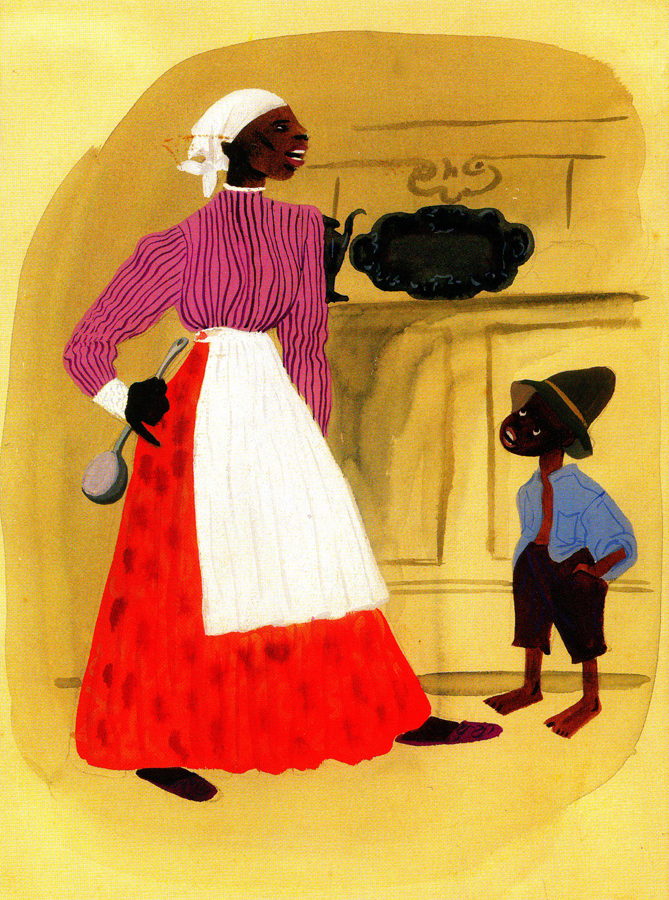 However bad the live action was, the animation was the polar opposite. The stories are told very economically with lots of excitement and life in the storytelling. All those who worked on it spoke openly about how much fun they had in doing it. Those results showed up on the screen. The characters are delightful and beautifully developed. This was certainly the spark everyone in the animation department needed as they came off years of toiling away at dry, training films for the military.
However bad the live action was, the animation was the polar opposite. The stories are told very economically with lots of excitement and life in the storytelling. All those who worked on it spoke openly about how much fun they had in doing it. Those results showed up on the screen. The characters are delightful and beautifully developed. This was certainly the spark everyone in the animation department needed as they came off years of toiling away at dry, training films for the military.
While the live action dates the material and plops it in a marginally racist context, the opposite is true of the combustible animation.
The Disney studio has hidden the DVD of this movie from the General Public. There are illegal copies of film circulating the Internet, but the quality could never be as good as a studio sanctioned copy of the movie. It’s truly unfortunate, for the sake of that great animation, that the film is inaccessible.
Korkis’ book is a very quick read and he seems to cover the story well. One would have liked a richer book with glossy images, especially of the beautifully designed Mary Blair animation.One wishes that there were lots of stills of the great Bill Peet storyboard or those great animation drawings by the Nine Masters who were truly in their prime. But we have what we have, and we’re thankful for that.

If you have any interest in this film you will have to get your hands on a copy. The last half of the book if filled with some essays about other, lesser films. Some of th essays are truly excellent and feel hidden in the back of this book. One, for example, about a commercial producing studio Walt had on the lot. Learning that Walt’s daughter, Sharon, worked as an assistant to his sister-in-law’s sister, who ran the company, would seem to be a key piece of information. But when you start to learn who Walt used to do the animation work (Tom Oreb designing for Charles Nichols directing with Phil Duncan, Amby Paliwoda, Volus Jones and Bill Justice all were among those animating. There’s even the story of Bill Peet being punished by Walt and made to work on a Peter Pan peanut butter campaign.) This is an excellent piece. As is the story behind The Sweatbox, the feature documentary that was hidden by the Disney studio about the adventures in the making of the Emperor’s New Groove. Lots to read here.
All in all, this book is an excellent bargain.
All of these illustrations were done by Mary Blair for the film.
They’re not part of Jim Korkis’ book.On Thursday I’ll repost Bill Peet’s storyboard for The Tar baby.
Articles on Animation &Books &Commentary 18 Feb 2013 04:59 am
Appreciation
The deeper you go, the deeper you go.
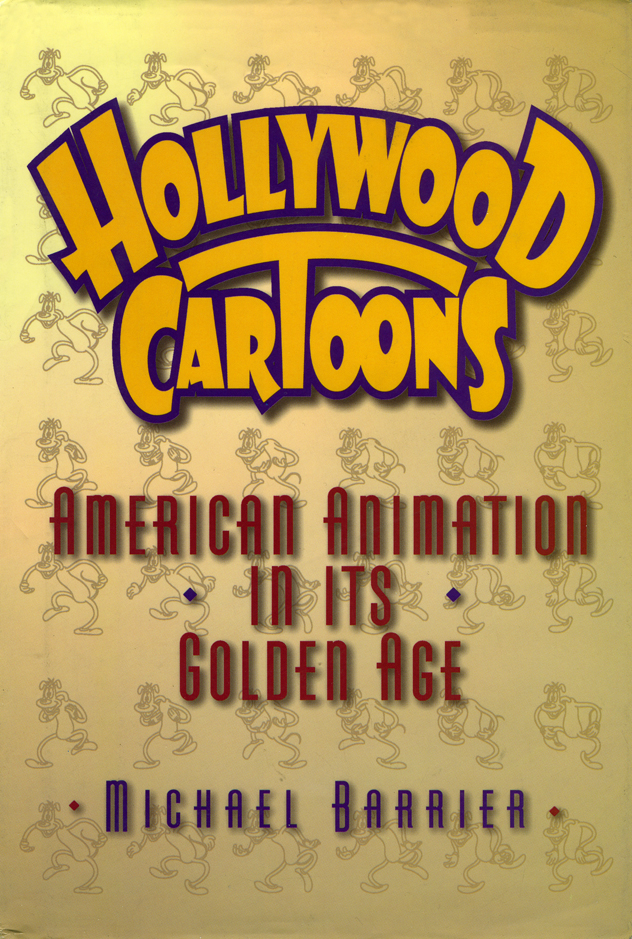 In reviewing the two J.B. Kaufman books on Snow White and the Seven Dwarfs, I found them impeccable in their attempt to reconstruct the making of this incredibly important movie. They followed a strict pattern of analyzing the film in a linear fashion going from scene one to the end.
In reviewing the two J.B. Kaufman books on Snow White and the Seven Dwarfs, I found them impeccable in their attempt to reconstruct the making of this incredibly important movie. They followed a strict pattern of analyzing the film in a linear fashion going from scene one to the end.
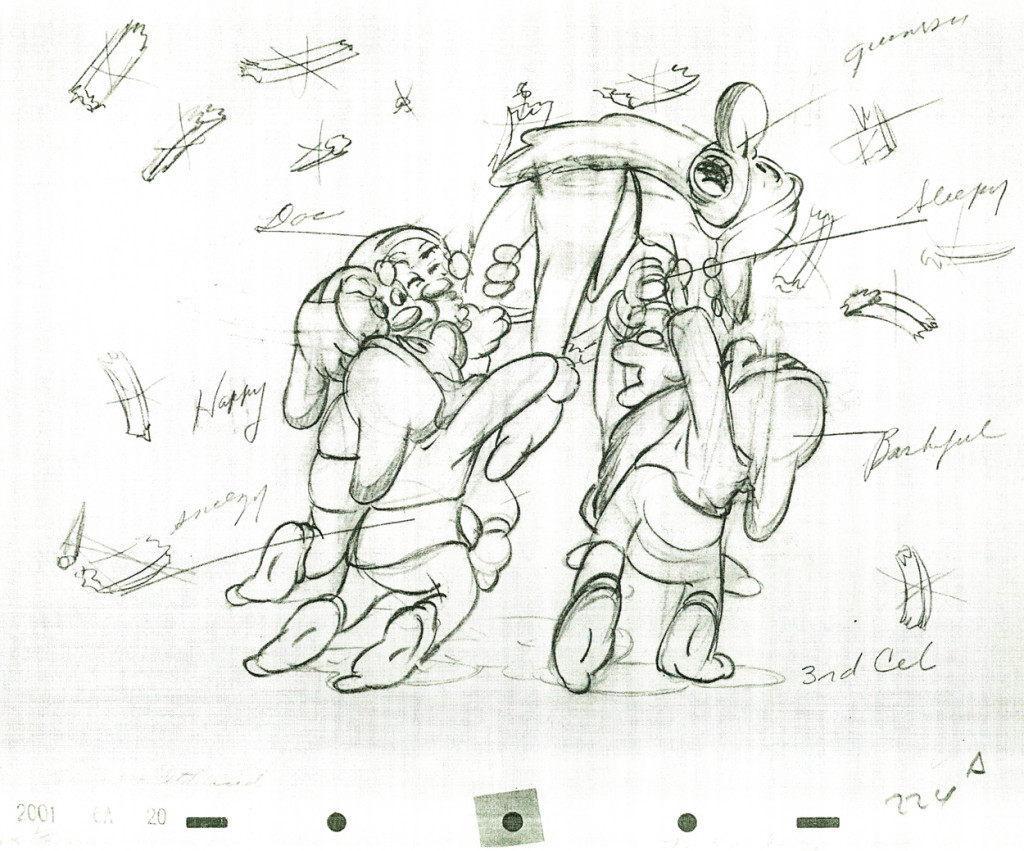 However, the analysis Kaufman offered brought me back to the bible, Mike Barrier‘s Hollywood Cartoons. Rereading his chapter on Snow White, you realize how much depth he offers in a far shorter amount of space. Of course, there are few illustrations in Barrier’s book, but what writing is there is golden. He meticulously analyzes the work of different animators using a very strict code of principles. If you can agree with him, the book he’s written opens up enormously.
However, the analysis Kaufman offered brought me back to the bible, Mike Barrier‘s Hollywood Cartoons. Rereading his chapter on Snow White, you realize how much depth he offers in a far shorter amount of space. Of course, there are few illustrations in Barrier’s book, but what writing is there is golden. He meticulously analyzes the work of different animators using a very strict code of principles. If you can agree with him, the book he’s written opens up enormously.
 Once you get to the chapter, post-Snow White, which catalogues the making of Pinocchio, Fantasia, Bambi and Dumbo you are in the deep water. Mike pointedly criticizes some of the greatest animation ever done. His analysis of Bill Tytla’s Stromboli is ruthless. Though I am an enormous fan of this animation, I cannot say I disagree with what he has to say. Though I think differently of the animation.
Once you get to the chapter, post-Snow White, which catalogues the making of Pinocchio, Fantasia, Bambi and Dumbo you are in the deep water. Mike pointedly criticizes some of the greatest animation ever done. His analysis of Bill Tytla’s Stromboli is ruthless. Though I am an enormous fan of this animation, I cannot say I disagree with what he has to say. Though I think differently of the animation.
Here’s a long excerpt from this chapter:
- No animator suffered more in this changing environment than Tytla. His expertise is everywhere evident in his animation of Stromboli—in the sense of Stromboli’s weight and in his highly mobile face—but however plausible Stromboli is as a flesh-and-blood creature, there is in him no cartoon acting on the order of what Tytla contributed to the dwarfs. At Pinocchio’s Hollywood premiere, Frank Thomas said, W. C. Fields sat behind him, “and when Stromboli came on he muttered to whoever was with him, ‘he moves too much, moves too much.’” Fields was right-although not for the reason Thomas advanced, that Stromboli “was too big and too powerful.”
- In the bare writing of his scenes, Stromboli, more than any of the film’s other villains, deals with Pinocchio as if he were, indeed, a wooden puppet—suited to perform in a puppet show, and perhaps to feed a fire—rather than a little boy. But the chilling coldness implicit in the writing for Stromboli finds no echo in the Dutch actor Charles Judels’s voice for the character. Judels’: Stromboli speaks patronizingly to Pinocchio, as he would to a gullible child, and his threat to use Pinocchio as firewood sounds like a bully’s bluster. As Tytla strained to bring this poorly conceived character to life, he lost the balance between feeling and expression. The Stromboli who emerges in Tytla’s animation is too vehement, “moves too much”; his passion has no roots, and so he is not convincing as a menace to Pinocchio, except in the crudest physical sense. There is nothing in Stromboli of what could have made him truly terrifying: a calm dismissal of Pinocchio as, after all, no more than an object.
- To some extent, Tytla may have been overcompensating for live action that even Ham Luske acknowledged was “underacted.” But Luske defended the use of live action for Stromboli by arguing that it had kept Tytla on a leash: “If he had been sitting at his board animating, without any live action to study, he might have done too many things.”
I agree, as Barrier says, that Stromboli is a flawed character, and I agree that the movement is broad and overstated. However, I think that this was Tytlas’s only possible entrance into the material, into trying to further the characterization. No, it could not be as deep as the work he’d done on Grumpy in Snow White, but the character of Stromboli isn’t as small as that name, “Grumpy”. A lot more was offered and had to be circled to simplify as best as possible for the small amount of screen time he would have in Pinocchio. And, yes, he comes off like a blowhard with a lot of bluster. But that’s not the way Pinocchio sees him. Pinocchio is made of wood, as Stromboli reminds us, but he is also an innocent, a child learning about the world.
Barrier’s chapter, as I said, moves quickly through this material covering four of the greatest Disney films; no, four of the greatest animated features ever done. In relatively few pages you feel as though he’s gotten it all in there and has even said more in depth than almost any historian about this period of Disney animation. I’ve read this chapter at least a dozen times, and it continues to grow richer for me. I think it’s possible the greatest piece ever written about animation.
Barrier’s writing, vocabulary, choice of phrase is all charged to keep the material tight. He’s writing a large book, and he has to get a lot in.
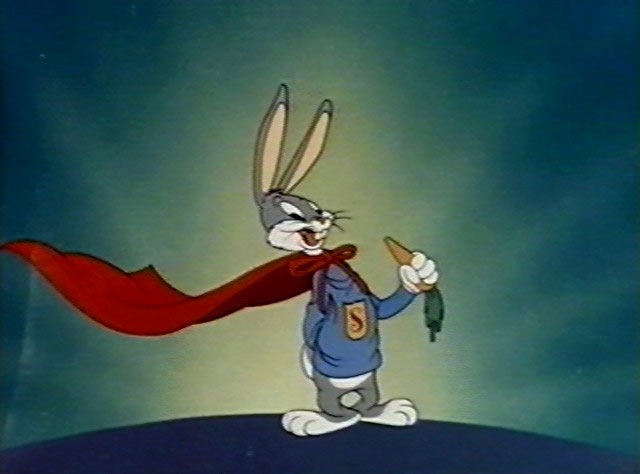 Perhaps some day he will have one of those big picture books to write where he will have the freedom to expound on the material. I did once read such a book. Mike Barrier had been employed to write a history of the Warner Bros. studio, and I got to read the first draft of the manuscript. I had a couple of hours and sat in a chair, thumbing pages. The images that were to be in the book were on large chromes. It was all an extraordinary experience for me, and I remember it somewhat hazily, as if remembering a golden afternoon. Of course that book was cancelled when management changed hands, and the world lost a great book.
Perhaps some day he will have one of those big picture books to write where he will have the freedom to expound on the material. I did once read such a book. Mike Barrier had been employed to write a history of the Warner Bros. studio, and I got to read the first draft of the manuscript. I had a couple of hours and sat in a chair, thumbing pages. The images that were to be in the book were on large chromes. It was all an extraordinary experience for me, and I remember it somewhat hazily, as if remembering a golden afternoon. Of course that book was cancelled when management changed hands, and the world lost a great book.
Can there be any wonder that I go to the Barrier website daily, knowing full well that it’s often months between posts? I just keep looking for new material from him, and will continue my daily routine hoping for the small brightly colored package on his site. It’s almost important for there not to be frequent posts or the new ones wouldn’t always shine as well. However, two or three times a year, there is something rich there, and my search has brought the golden fish. (Yes, I’m exaggerating somewhat like Tytla did in his animation of Stromboli. But the point gets made.)
Even if there’s nothing new there, there’s plenty old. Many old Funnyworld articles or interviews done with Milt Gray. It’s a deep site full of deep writing.
Books &Commentary &Photos &repeated posts 17 Feb 2013 06:51 am
Silents Please – recap
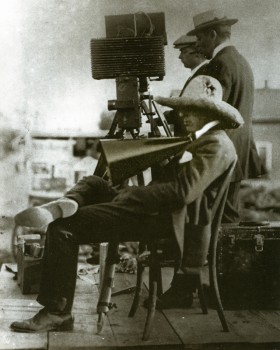 - I’m sure I’ve mentioned before that I love silent films. I particularly am a fan of D.W.Griffith‘s work. I think I’ve read just about every book about the man’s career and biography.
- I’m sure I’ve mentioned before that I love silent films. I particularly am a fan of D.W.Griffith‘s work. I think I’ve read just about every book about the man’s career and biography.
If you’re looking for a great one, read Adventures with D.W. Griffith by Karl Brown, who was an apprentice on Birth of a Nation and Intolerance. I think often enough about Brown’s story about his daily walks with D.W. It seems that they both lived near 14th Street, and their studio was on 125th St. when they worked in NY. They’d walk together to the studio in the morning and walk home at night. The young Karl Brown would use the opportunity to learn as much as he could from the master. He tells how Griffith, at one time, pulled out a big six shooter which surprised Brown. That’s when he realized that most people carried guns. It was protection from criminals. ______Griffith filming Birth of a Nation.
I’m sure it was also protection from the patent
holders group who would beat up anyone making a film without paying for the use of a camera, whose operation was patented and owned by Thomas Edison.
Billy Bitzer, Griffith’s brilliant cameraman, reconstructed their camera so that it was different from the patent rights’ group’s cameras – therefore not in violation of the patent. This didn’t stop the constant attacks on Griffith’s sets.
I have a book by Kevin Brownlow that I love. Photographs from the sets of silent films. Hollywood, the Pioneers is a companion book to a series he produced. The photos are outstanding. Here are a few:

Billy Bitzer on the front of a train filming the movement
for a pre-Griffith film, a Hales Tour film.
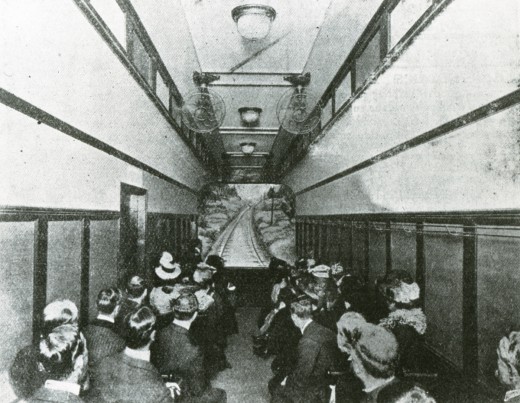
This is how the Hales tour films were screened. It’s a duplicate of a railroad car, and you ride facing the screen where you got to watch the movement, as if you were on a train. Future director, Byron Haskin, talked about spending whole days in a theater
watching these tours since they were so spellbinding.
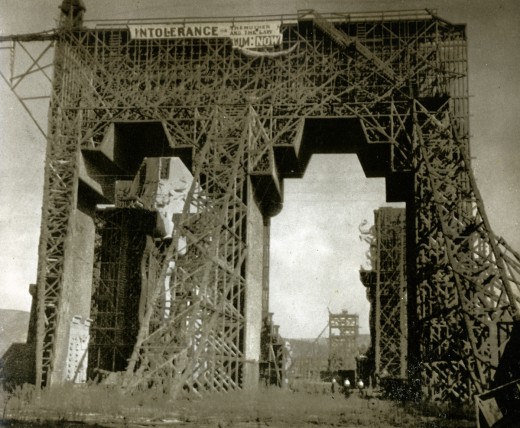
Here’s a shot of the skeleton to the set of Babylonia in the film, Intolerance.
This film was shot in California. Film makers ran to the west coast
as much to escape the patent holders as to find all sun all the time.
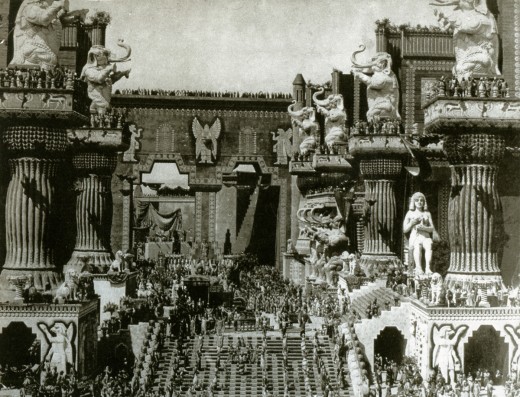
This is what the final set looked like for the film. (Those are
real people and elephants inhabiting the set, not computerized creations.)
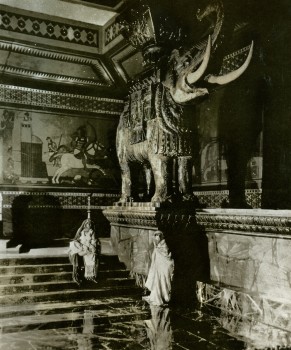 This is closer shot of one of the elephants that lined the walls. The care that was put into these films was amazing. Griffith loved recreating famous paintings and etchings that illustrated the stories he was filming. Quite often, the intertitle would tell you that you were watching such a recreation and show you the painting.
This is closer shot of one of the elephants that lined the walls. The care that was put into these films was amazing. Griffith loved recreating famous paintings and etchings that illustrated the stories he was filming. Quite often, the intertitle would tell you that you were watching such a recreation and show you the painting.
After the film was completed, the set remained standing for many years. If Roger Corman had been around at the time, there would have been another dozen films featuring it.
There’s also a wonderful Italian film by the Taviani brothers called, Good Morning, Babylon. It’s about two architect brothers who emigrate to the US and get work helping to build the set. It’s worth hunting down for a look.

The Griffith film led to bigger and bigger sets.
This is Ernst Lubitsch’s German film, Loves of a Pharoah.
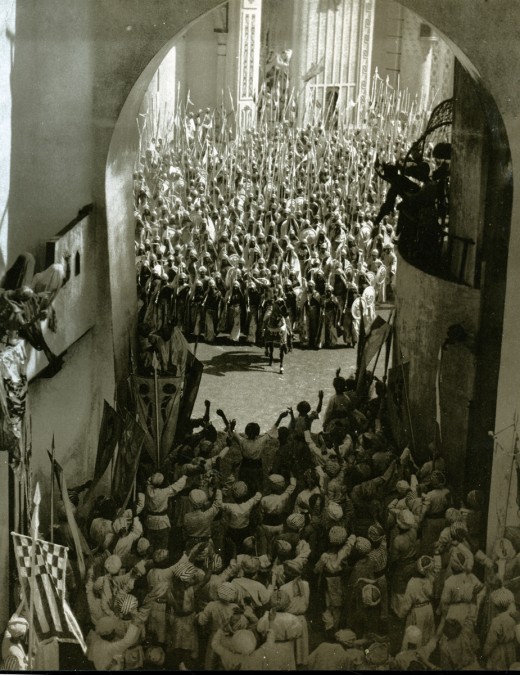
Douglas Fairbanks got even larger with his set for The Thief of Baghdad.
 Years later, after a number of films had failed for him, Griffith tried to make one more special film. He bought some land in Mamaroneck, NY and built his own studio. There he had constructed Paris. This would be the set for Orphans of the Storm.
Years later, after a number of films had failed for him, Griffith tried to make one more special film. He bought some land in Mamaroneck, NY and built his own studio. There he had constructed Paris. This would be the set for Orphans of the Storm.
It was a film that featured the sisters, Dorothy and Lillian Gish. The girls are separated in the period melodrama. here, Dorothy, playing the blind sister, is searching the streets for her sister.
She isn’t very successful and sinks lower and lower into the depths of revolutionary France. Needless to say, there’s eventually a reu-nion.
Lillian took a very big part in the making of these films. During Intolerance she actually was an uncredited editor. Since she had a small role in the film, she would spend the days assembling footage to view with D.W. in the evenings and would rework the film to Griffith’s instructions on the next day.
There was no script when they started this film. Griffith wrote it all and kept it in his head as he shot the film. This was quite a feat since it’s four separate stories that are interwoven. (The first time this was done on film.)
Anita Loos was employed, early in her career, after the fact to help write the intertitles and offer suggested changes to the footage.
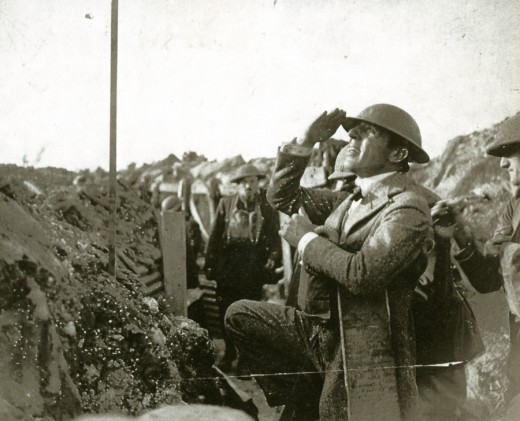
In 1917, during WW I, Griffith actually went to the French front to film his movie,
Hearts of the World. The film was financed with British money as
early propaganda. The footage shot in France wasn’t all he’d hoped for,
so some of it was recreated back in the US when he returned.
